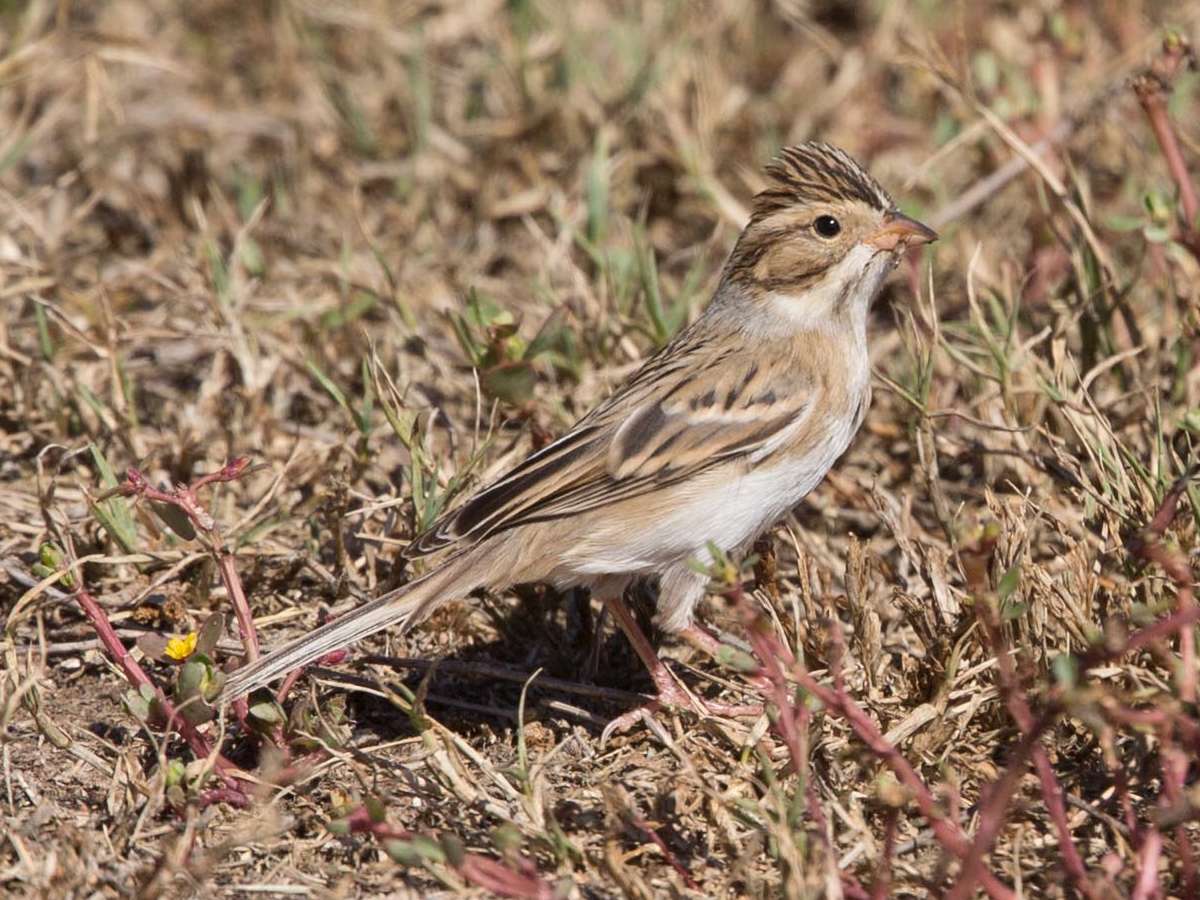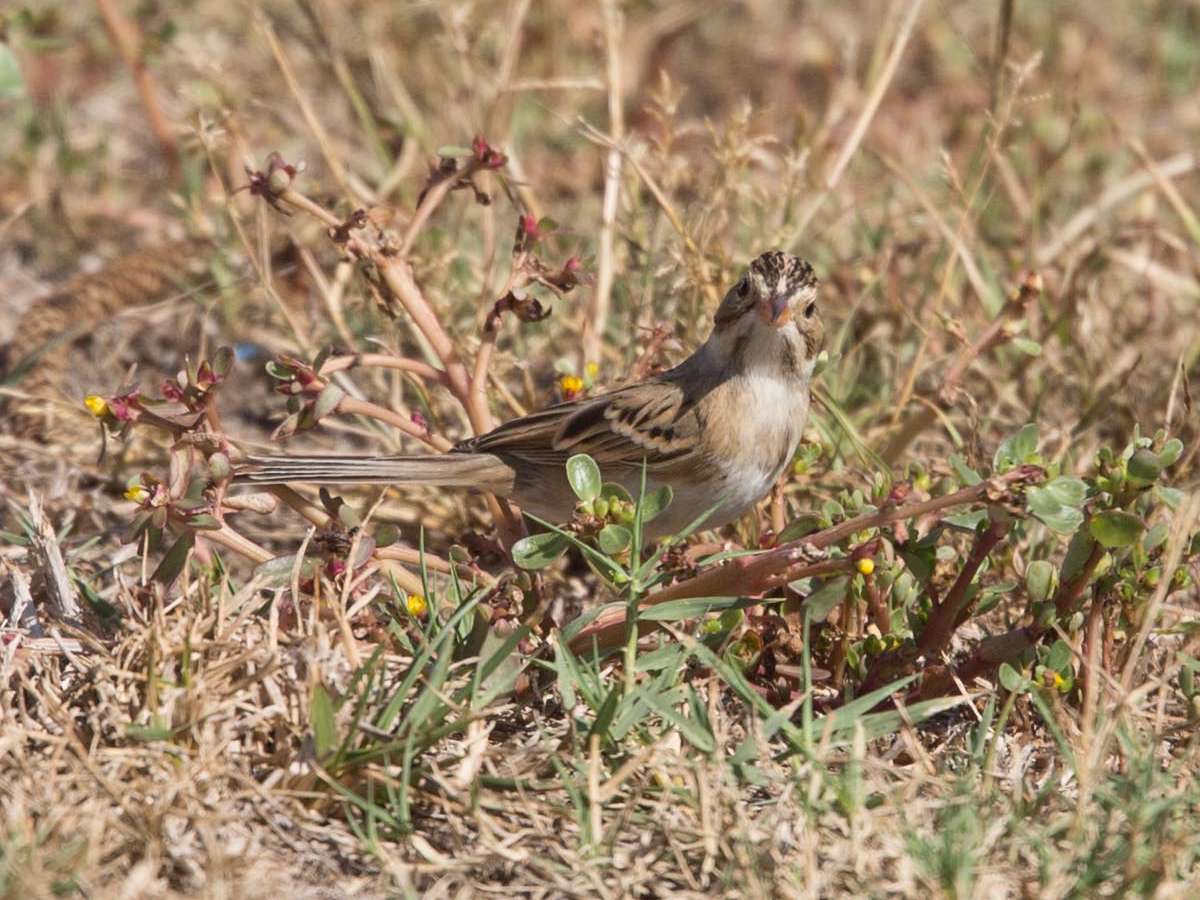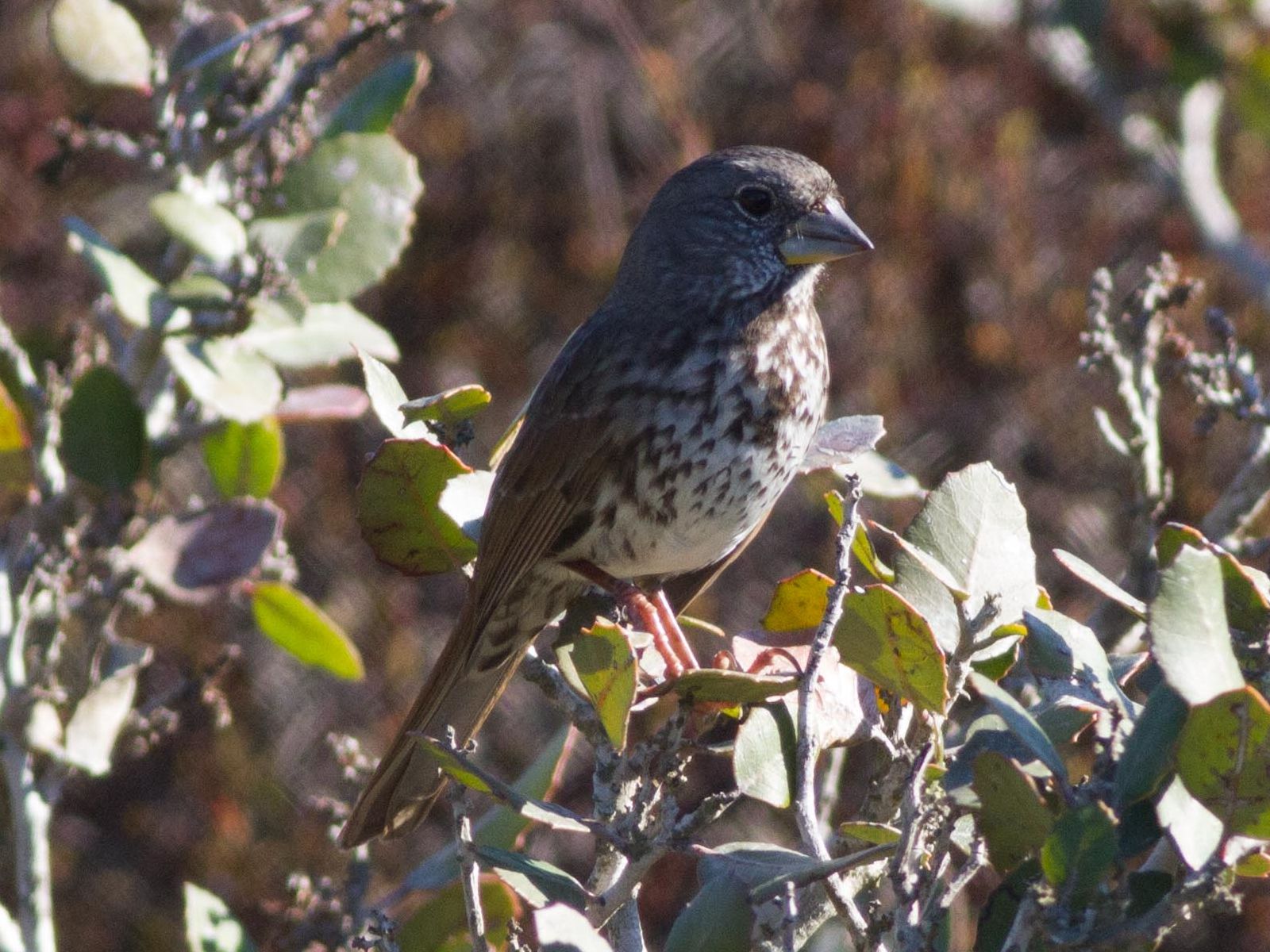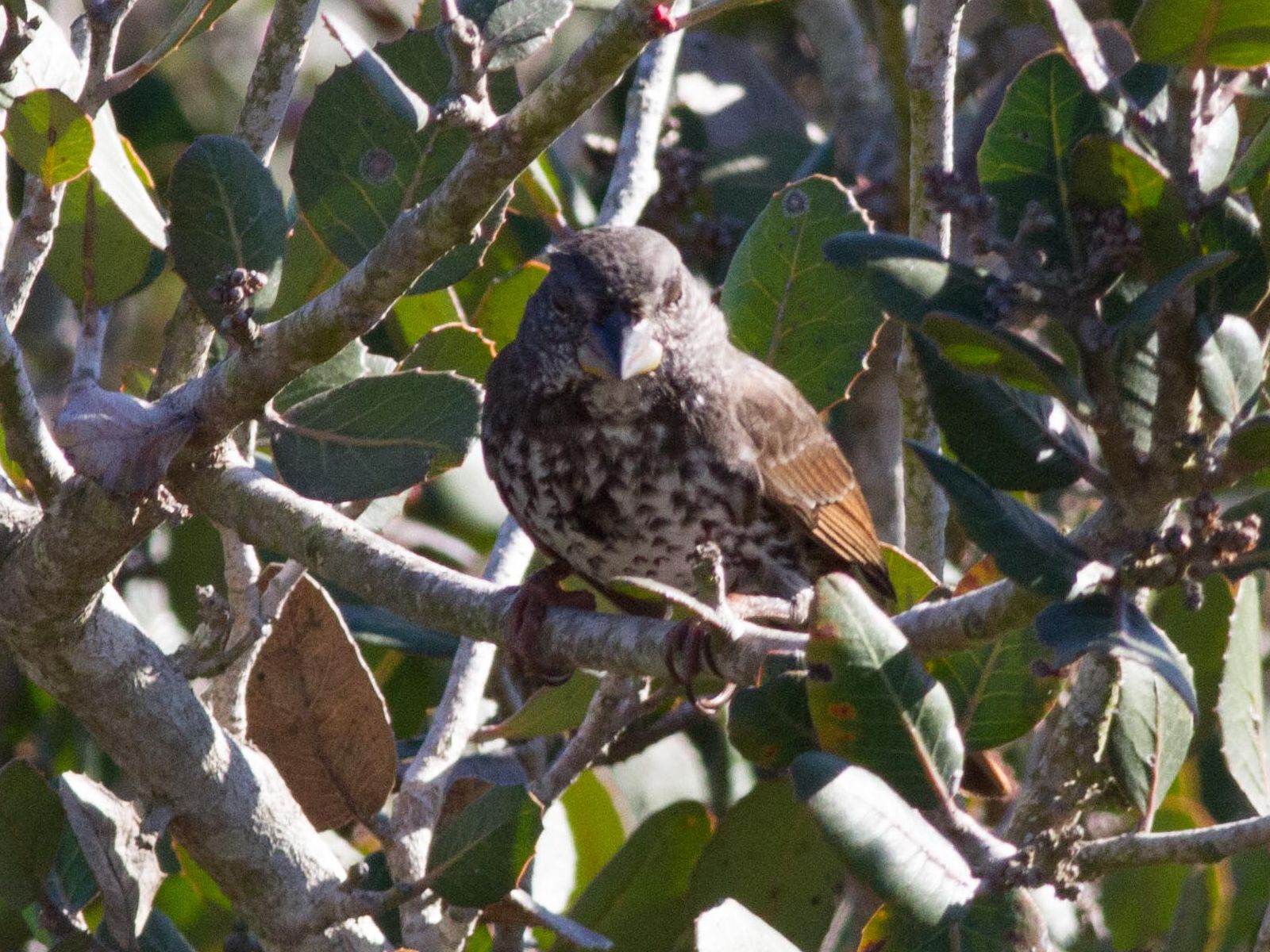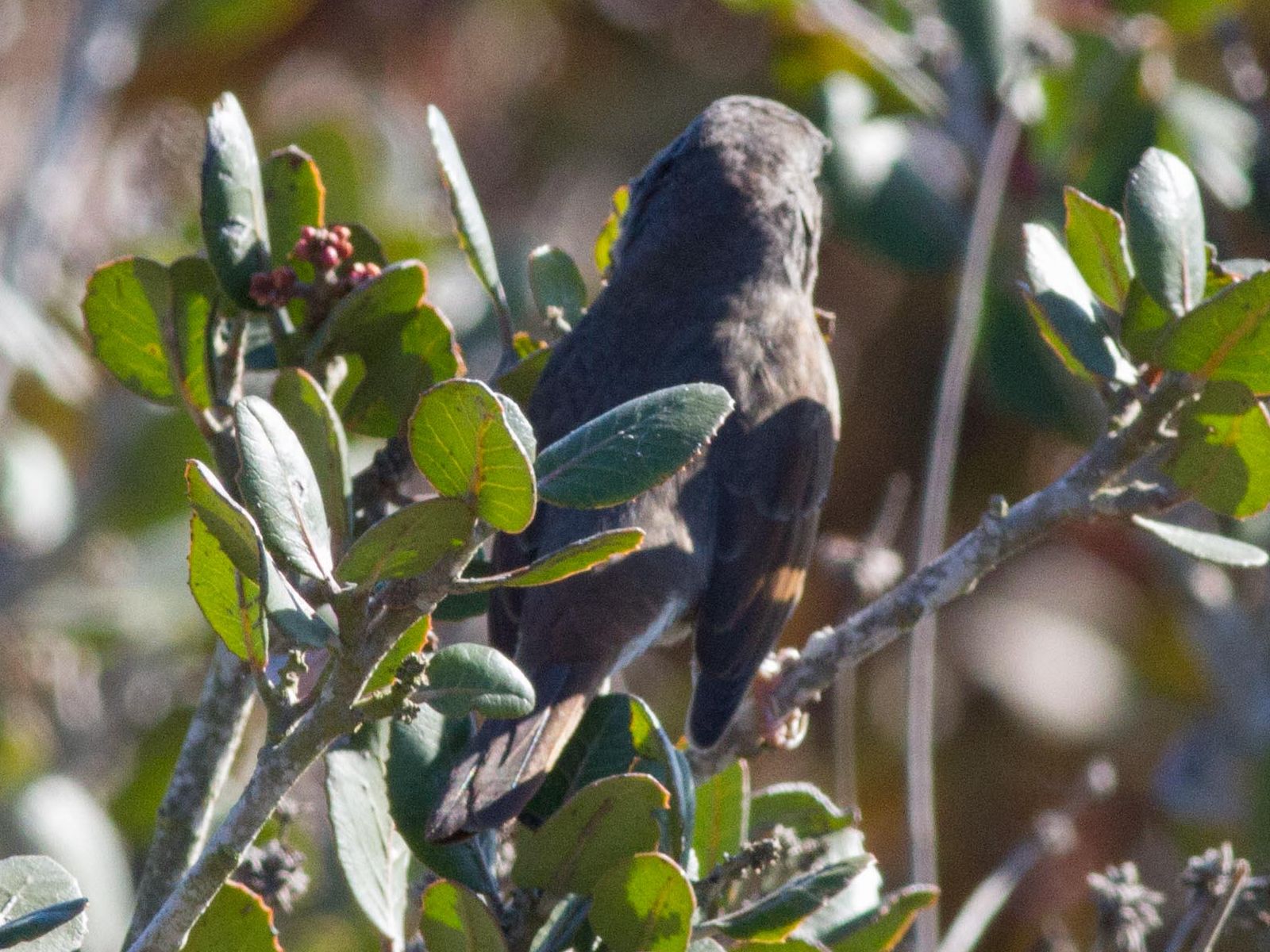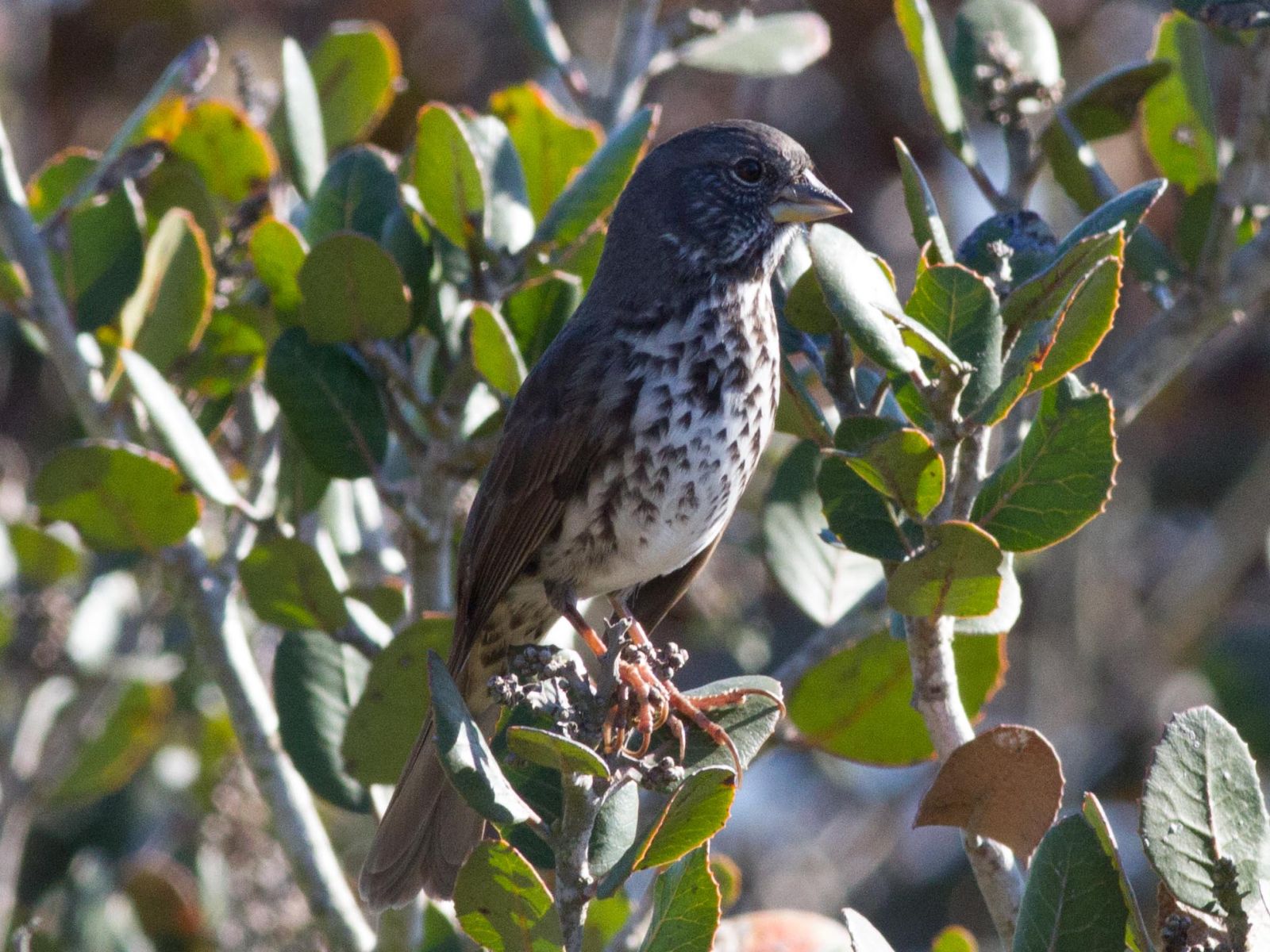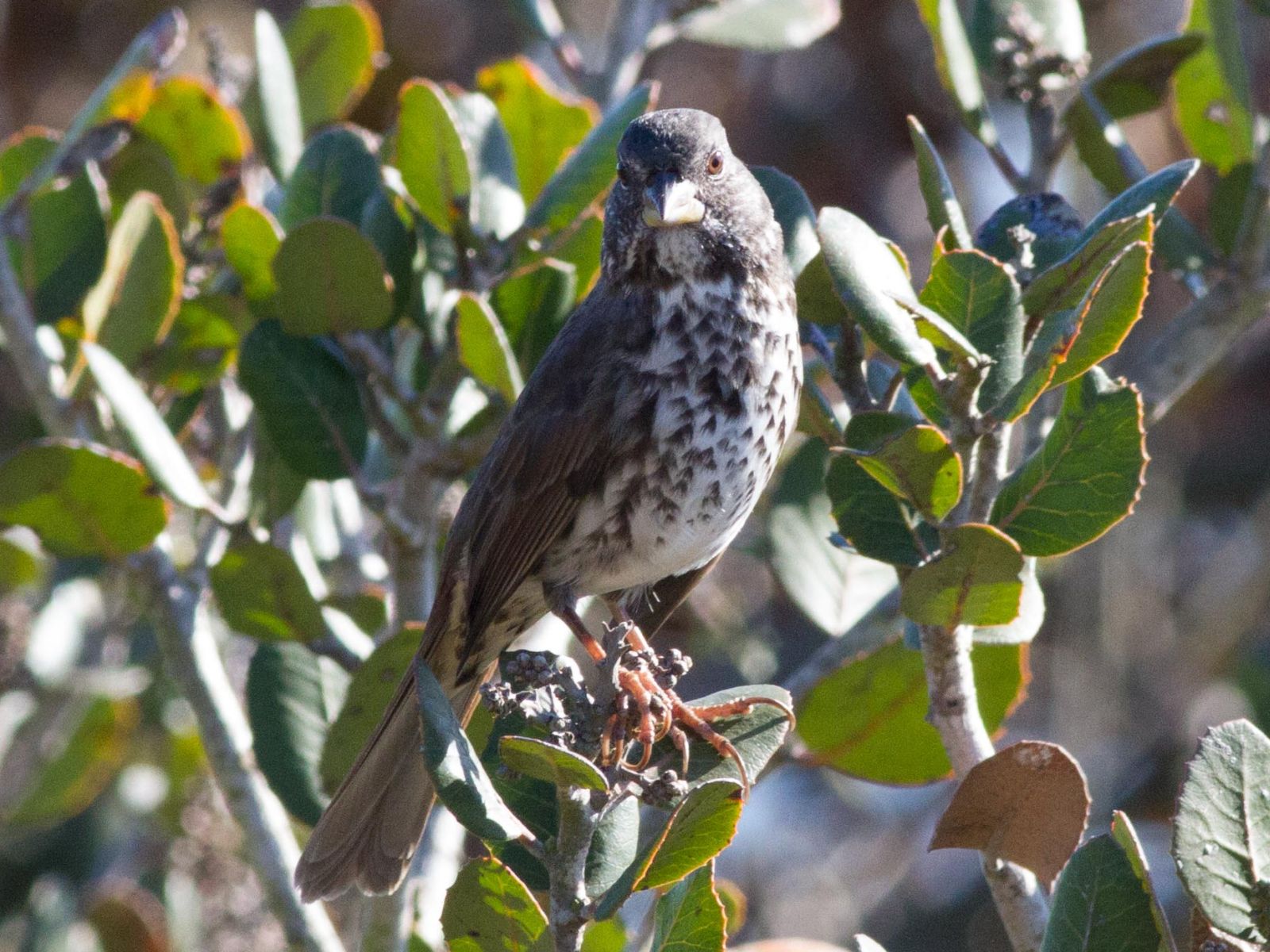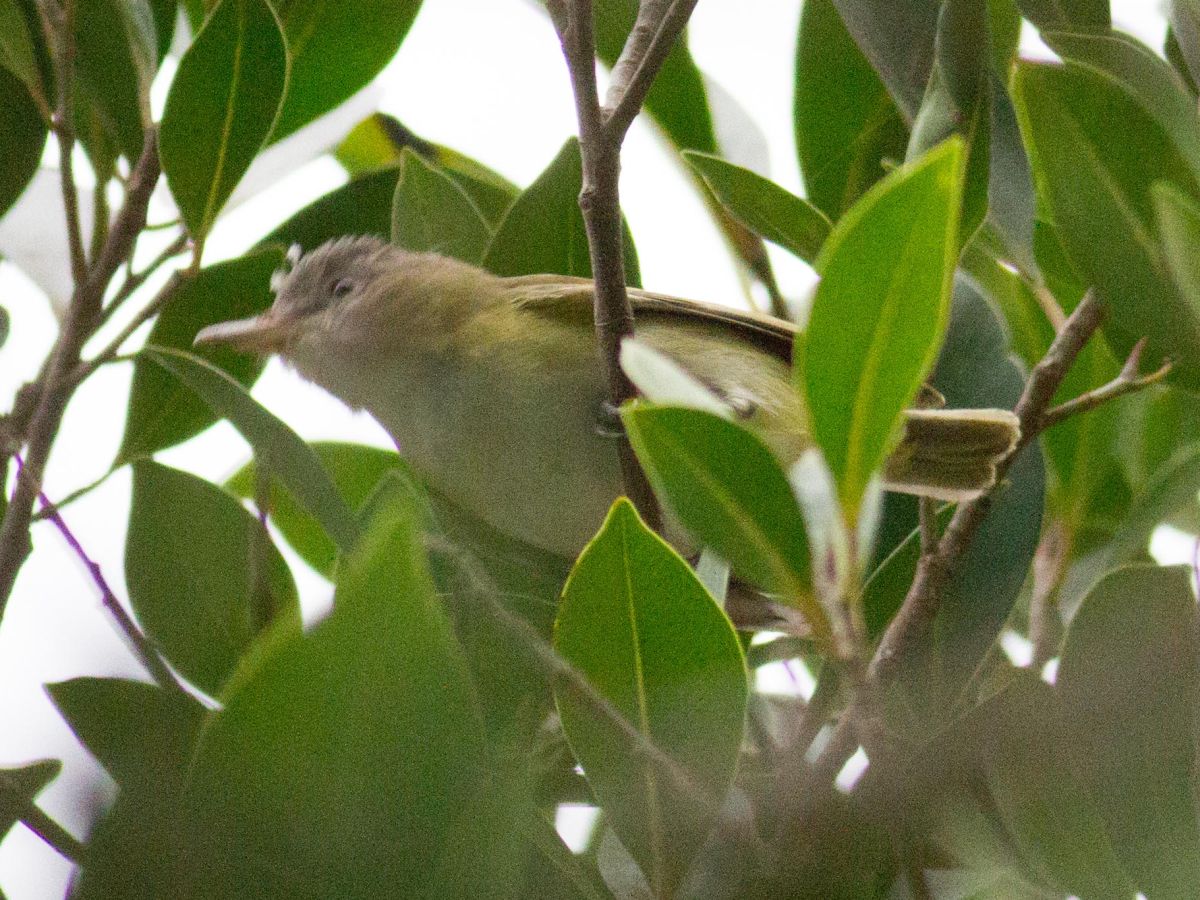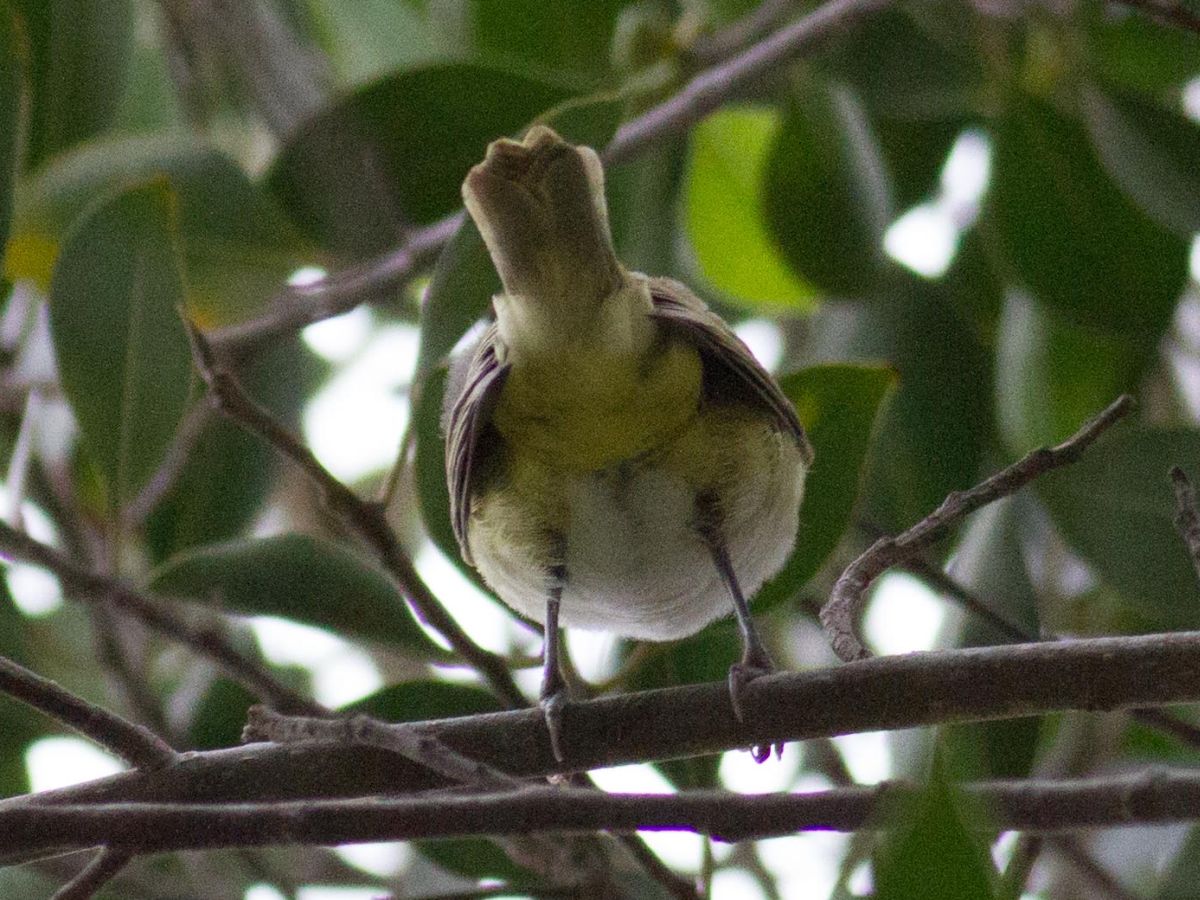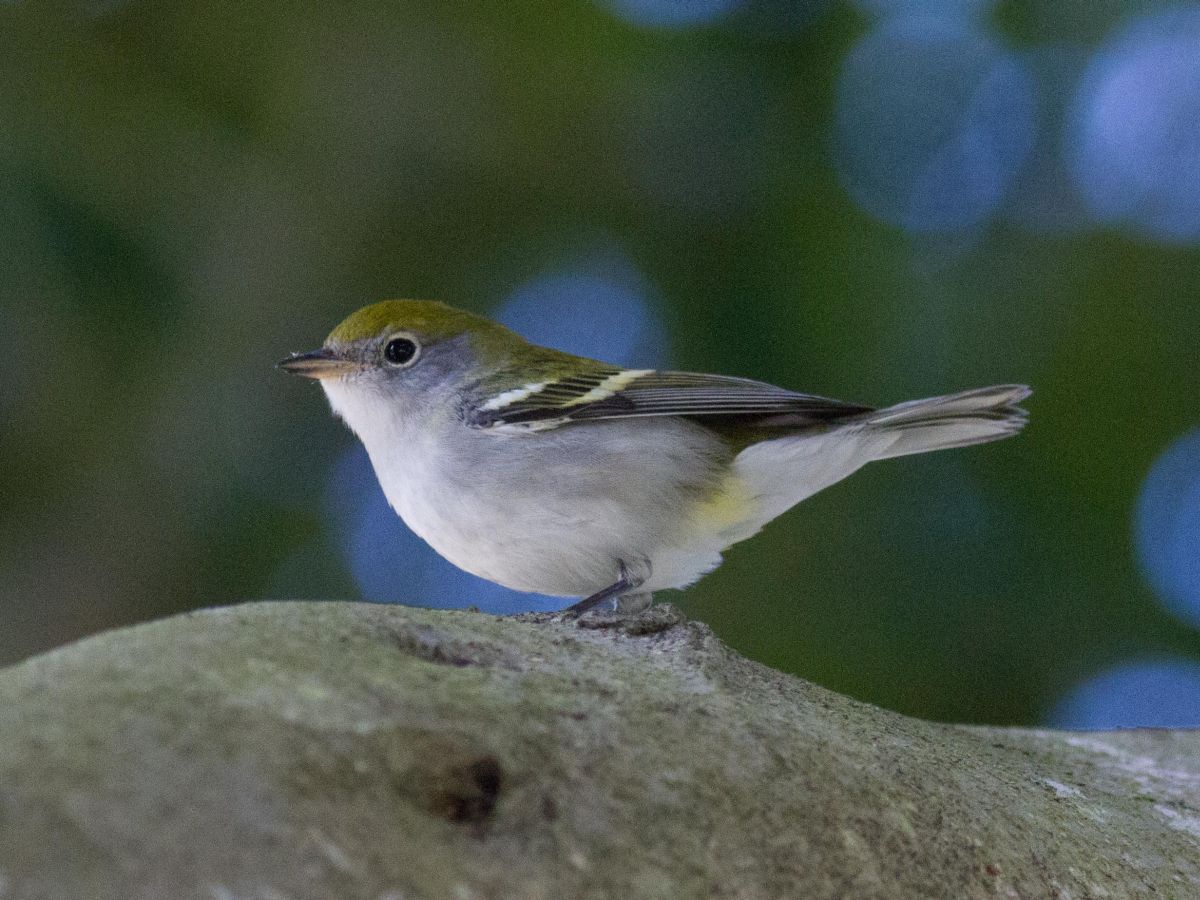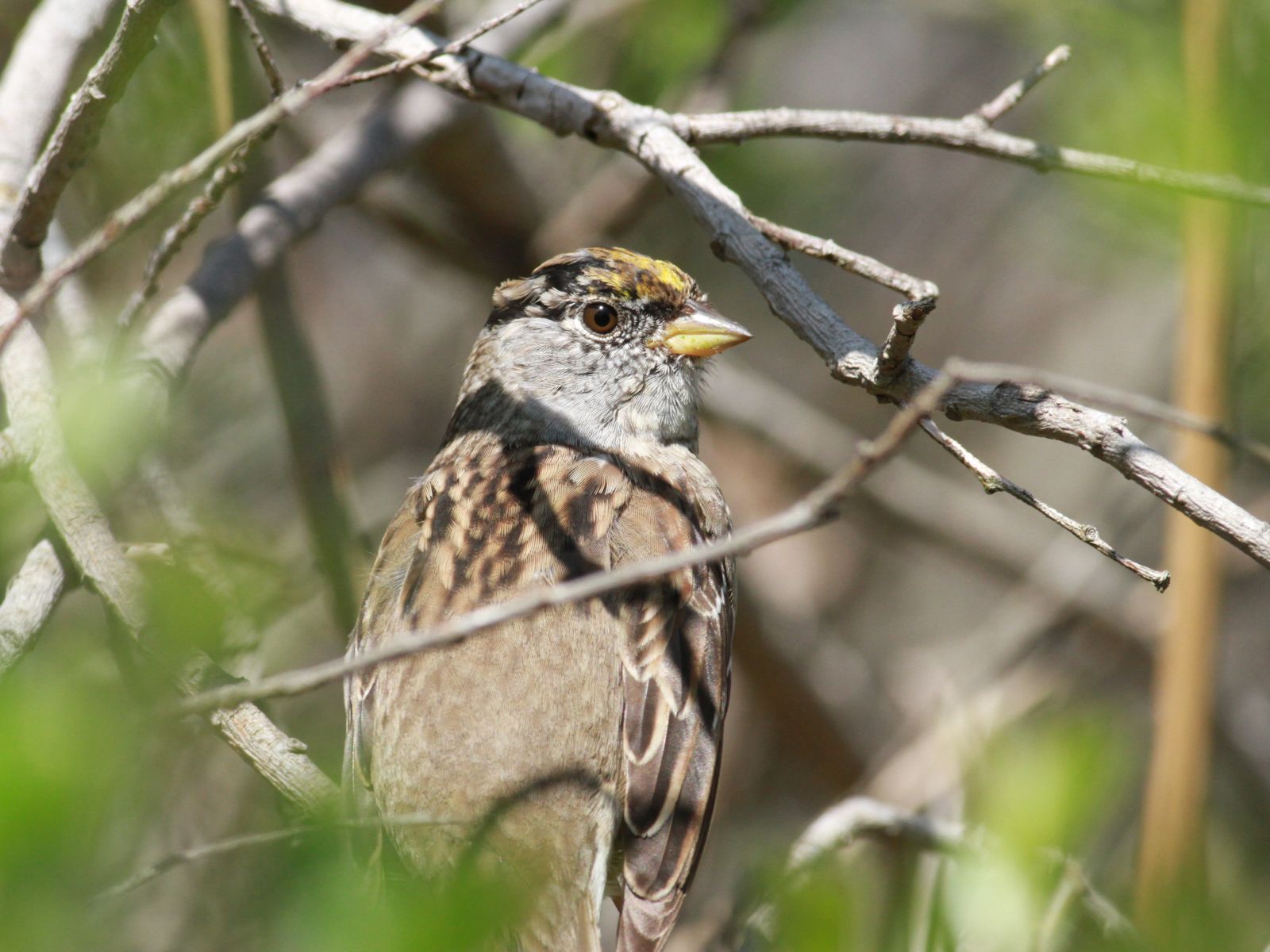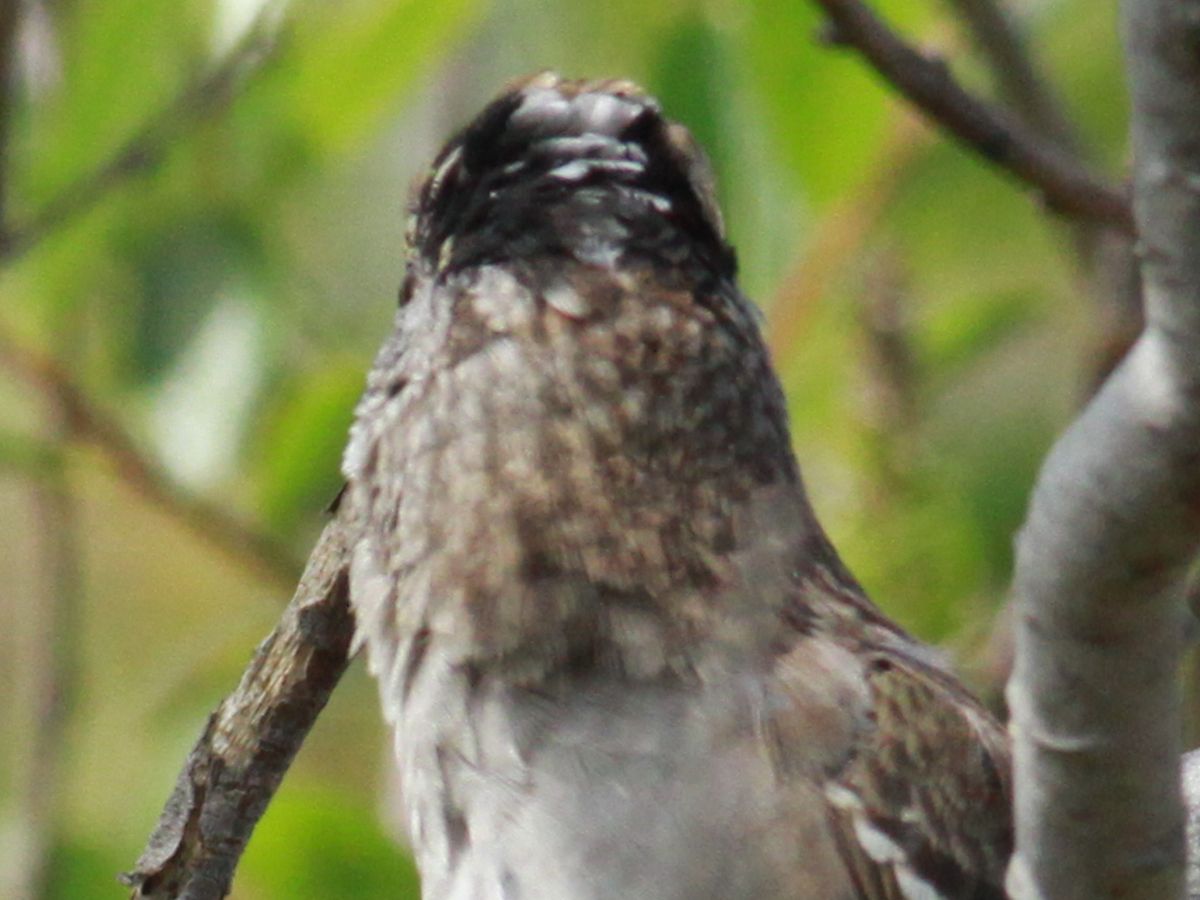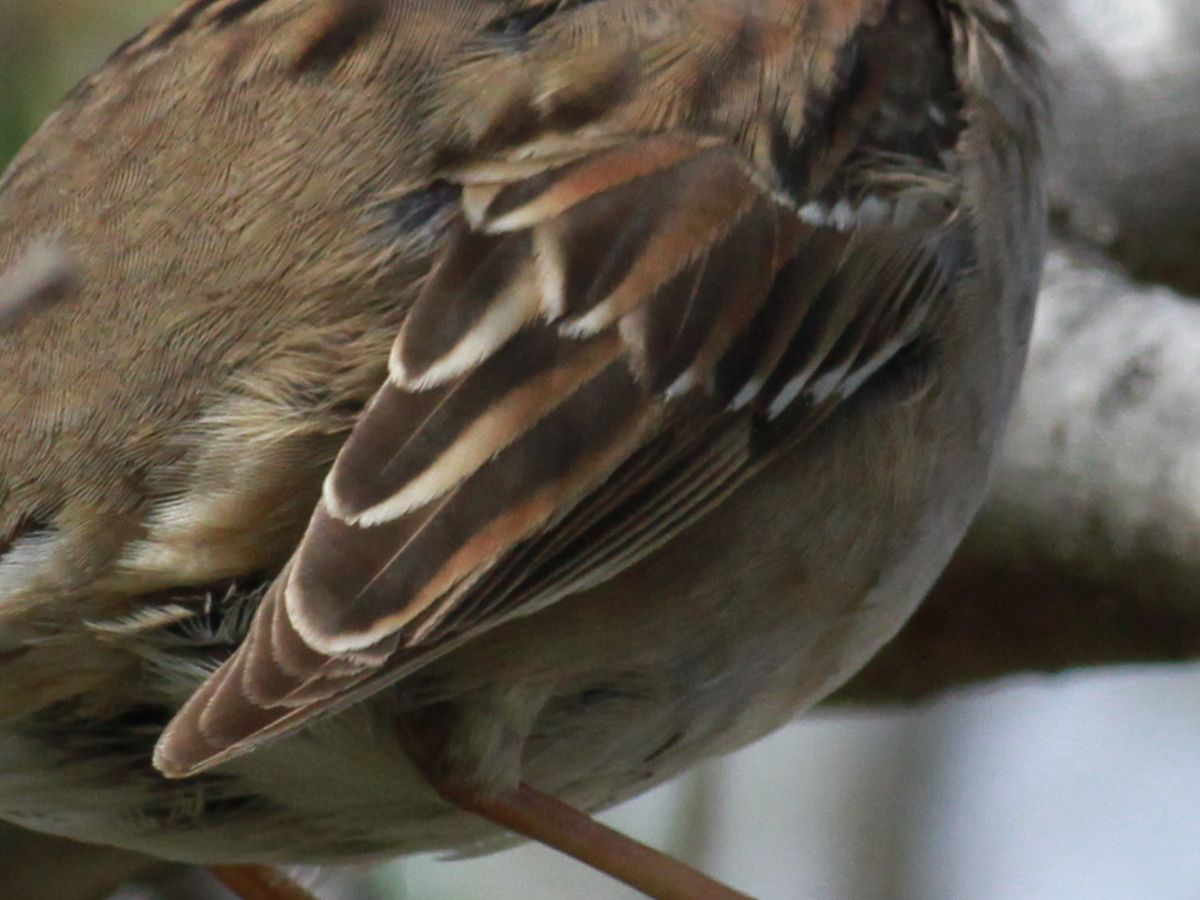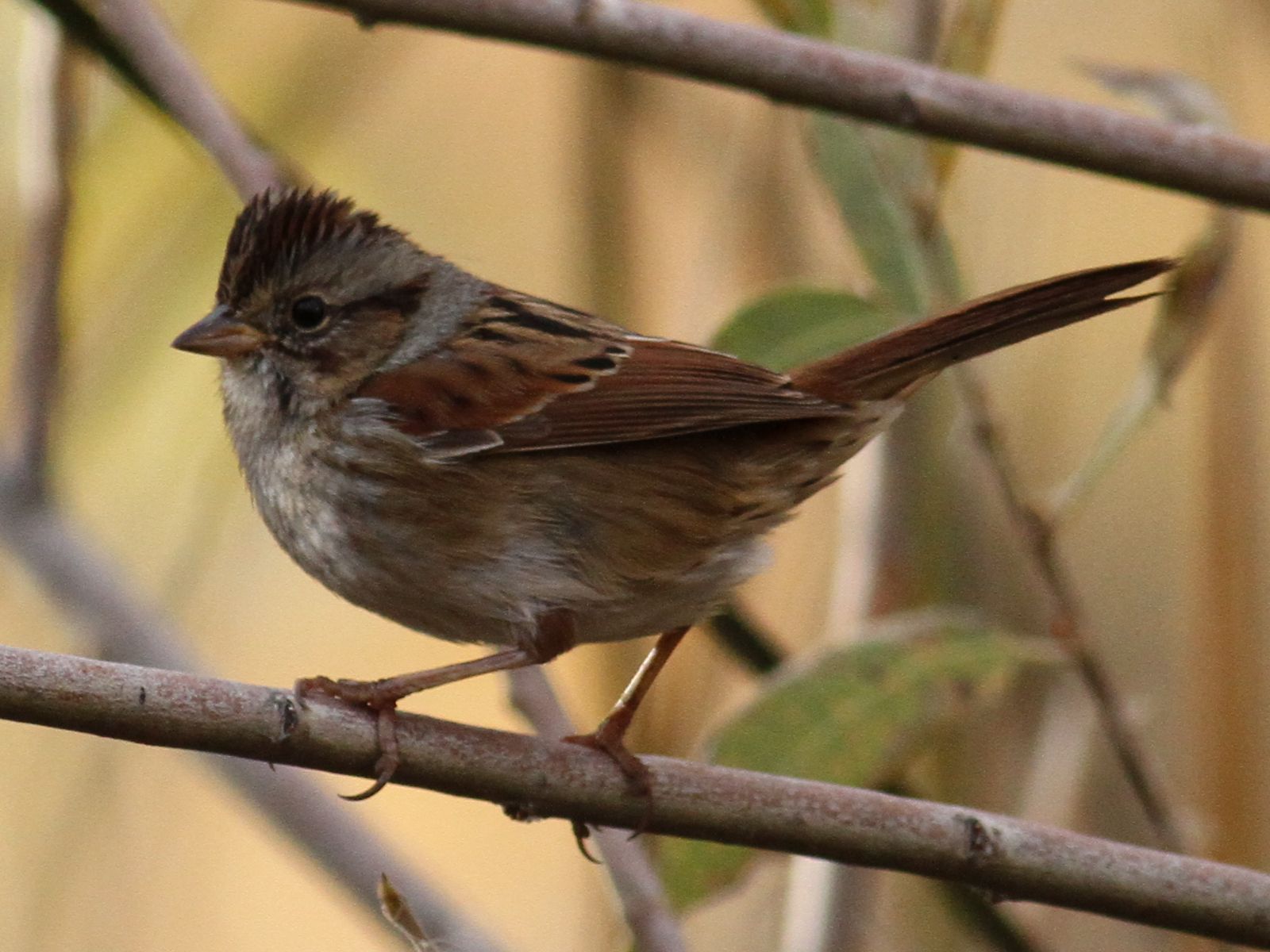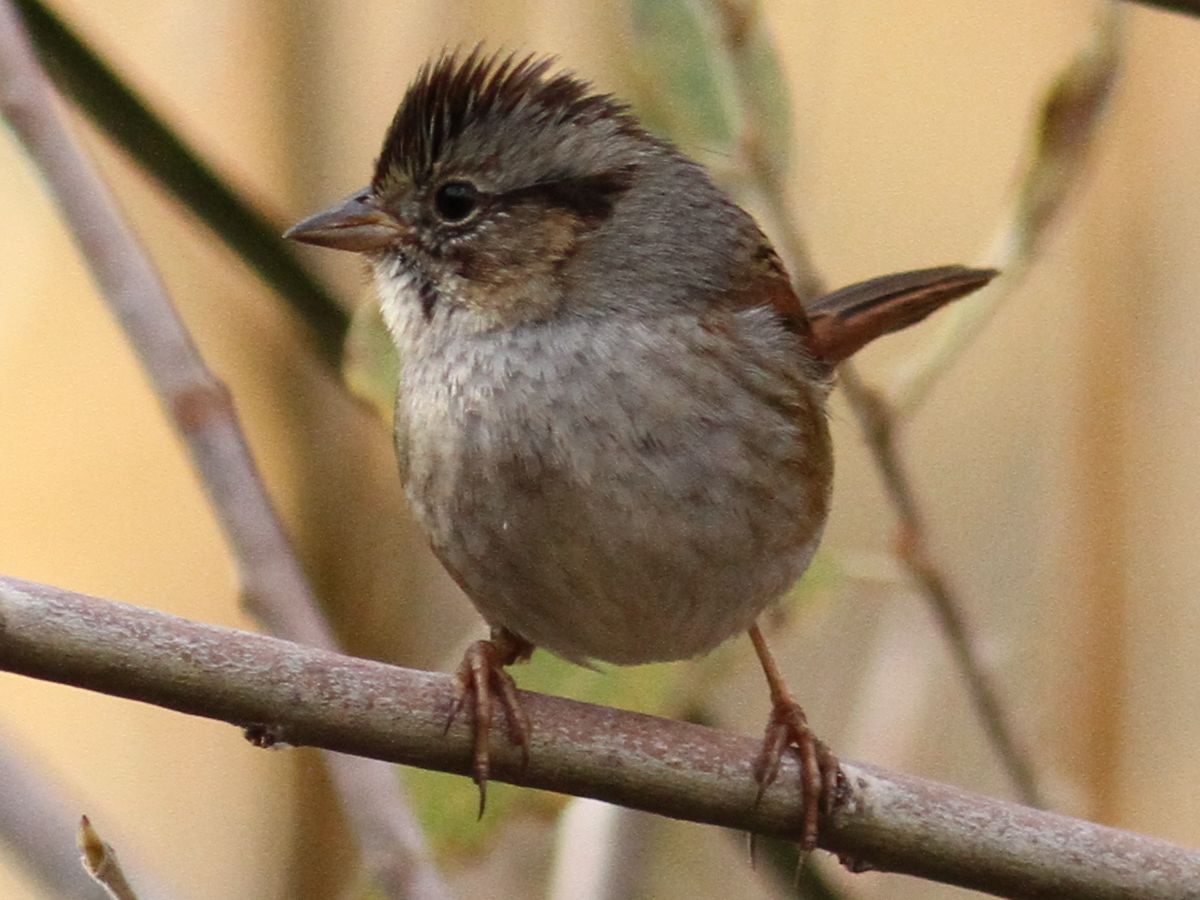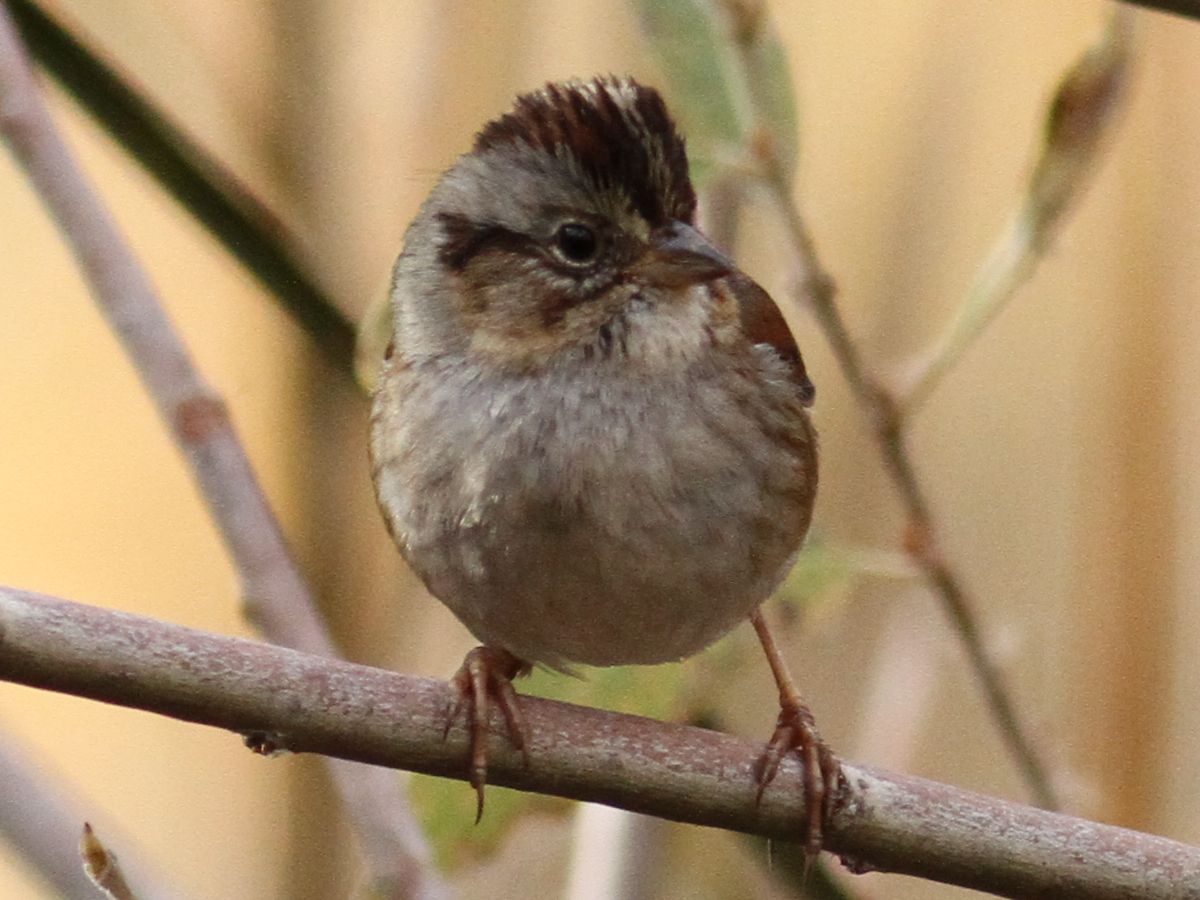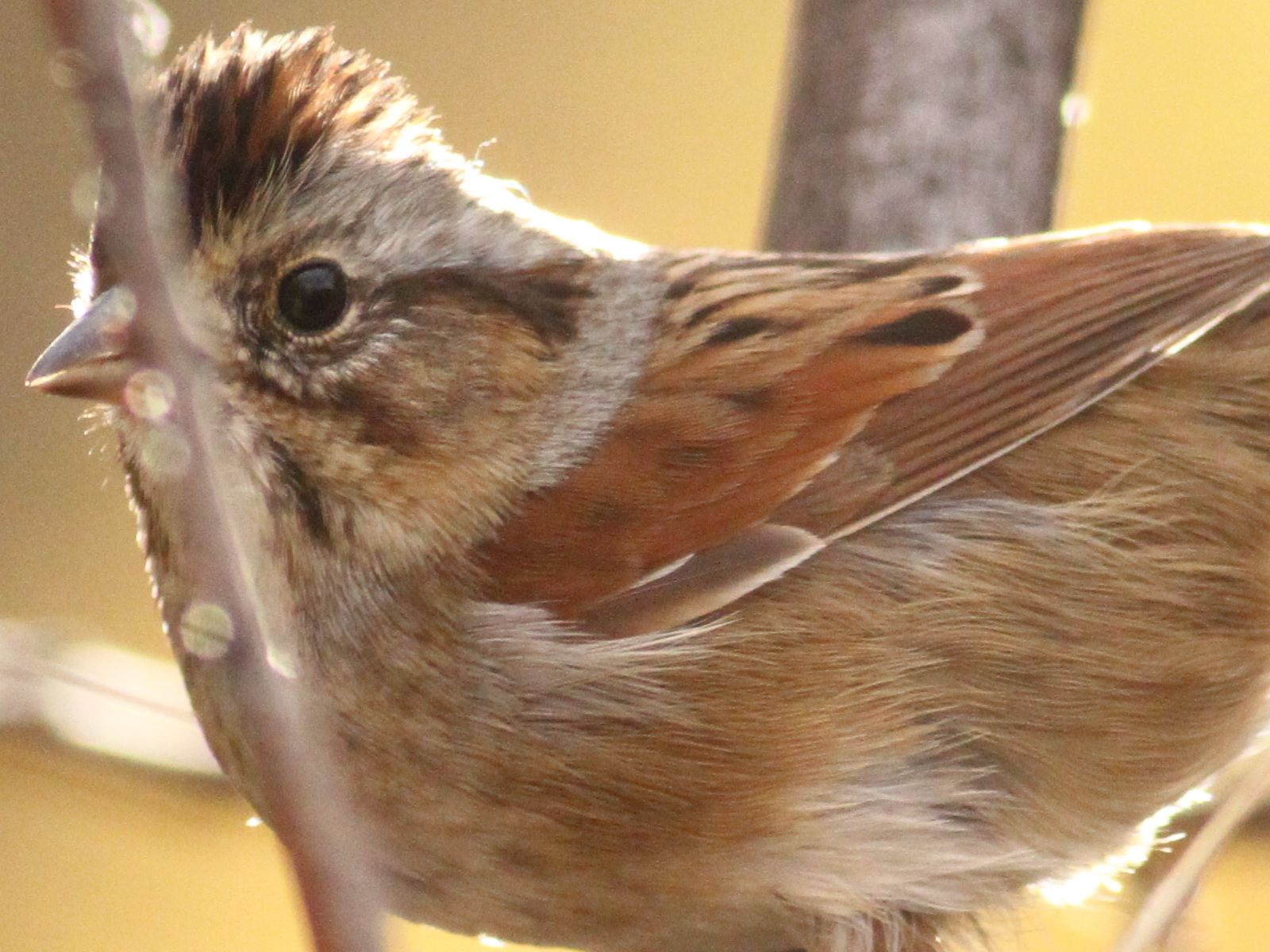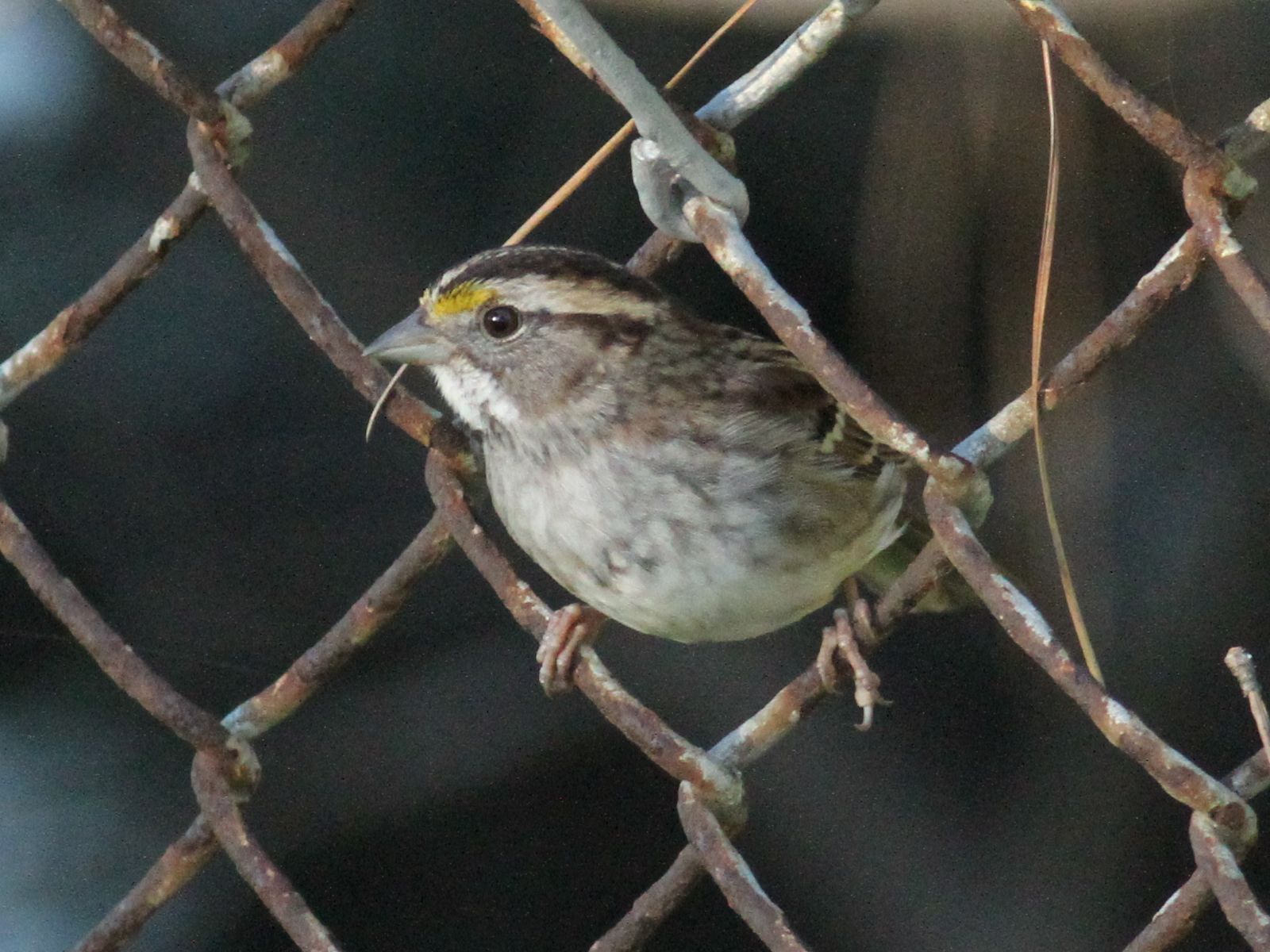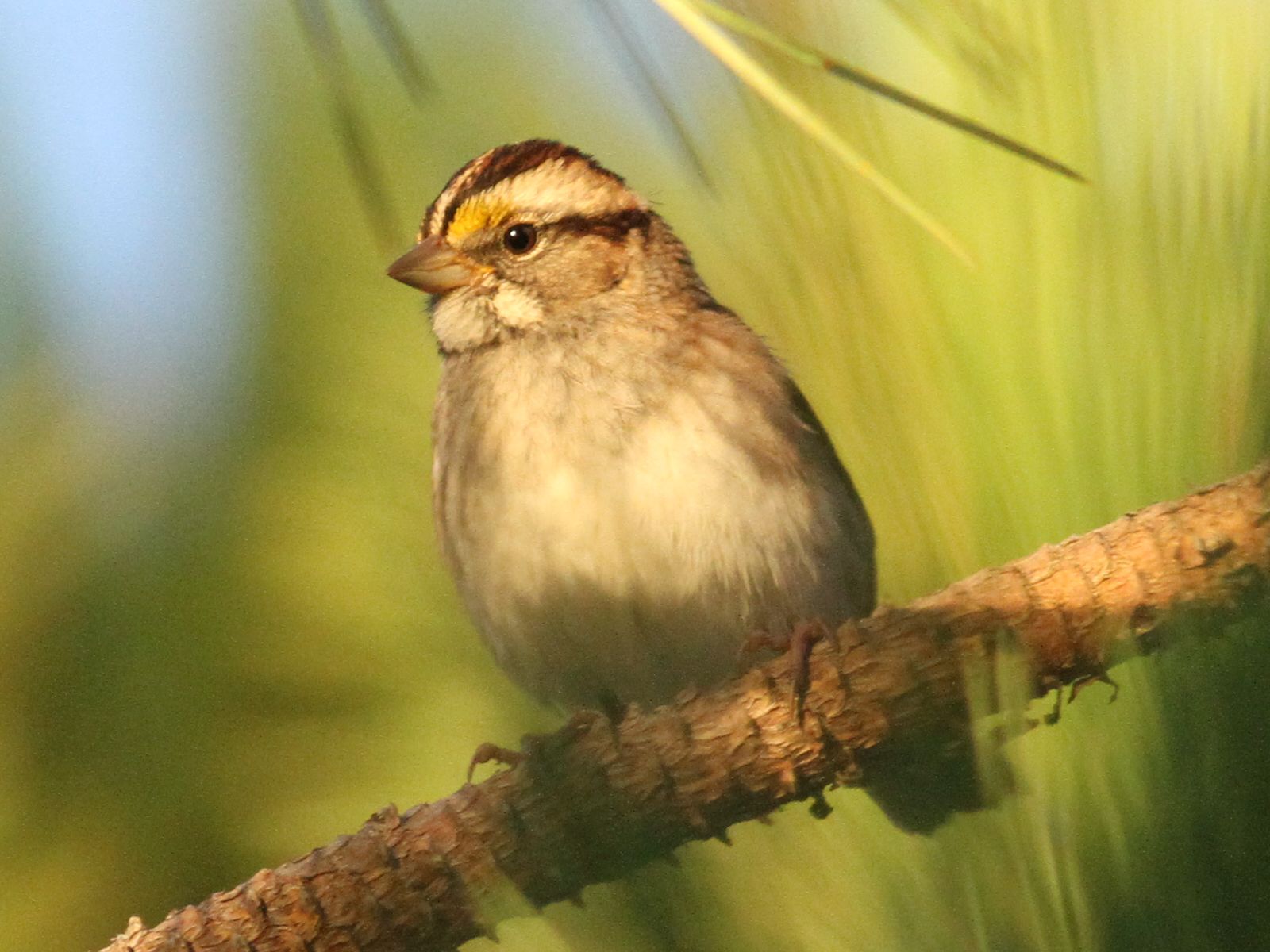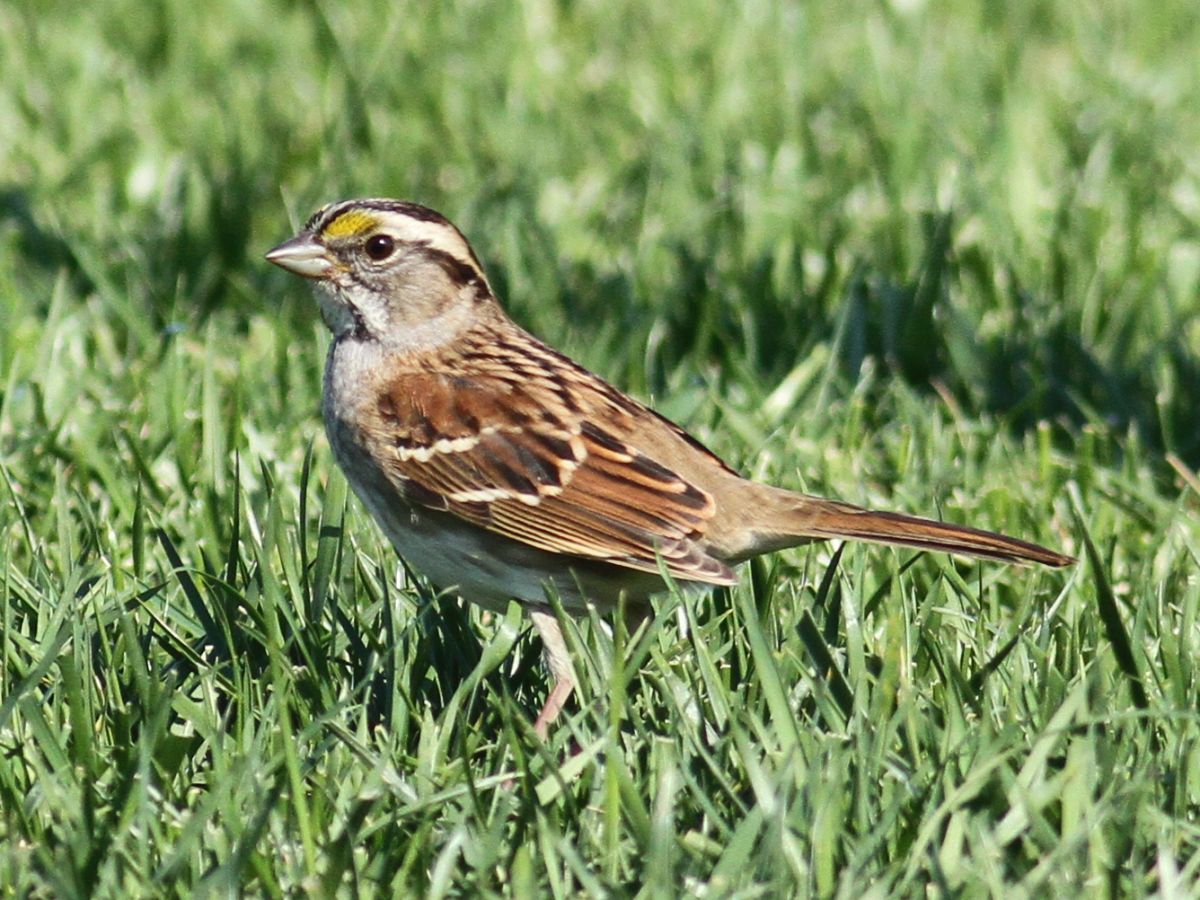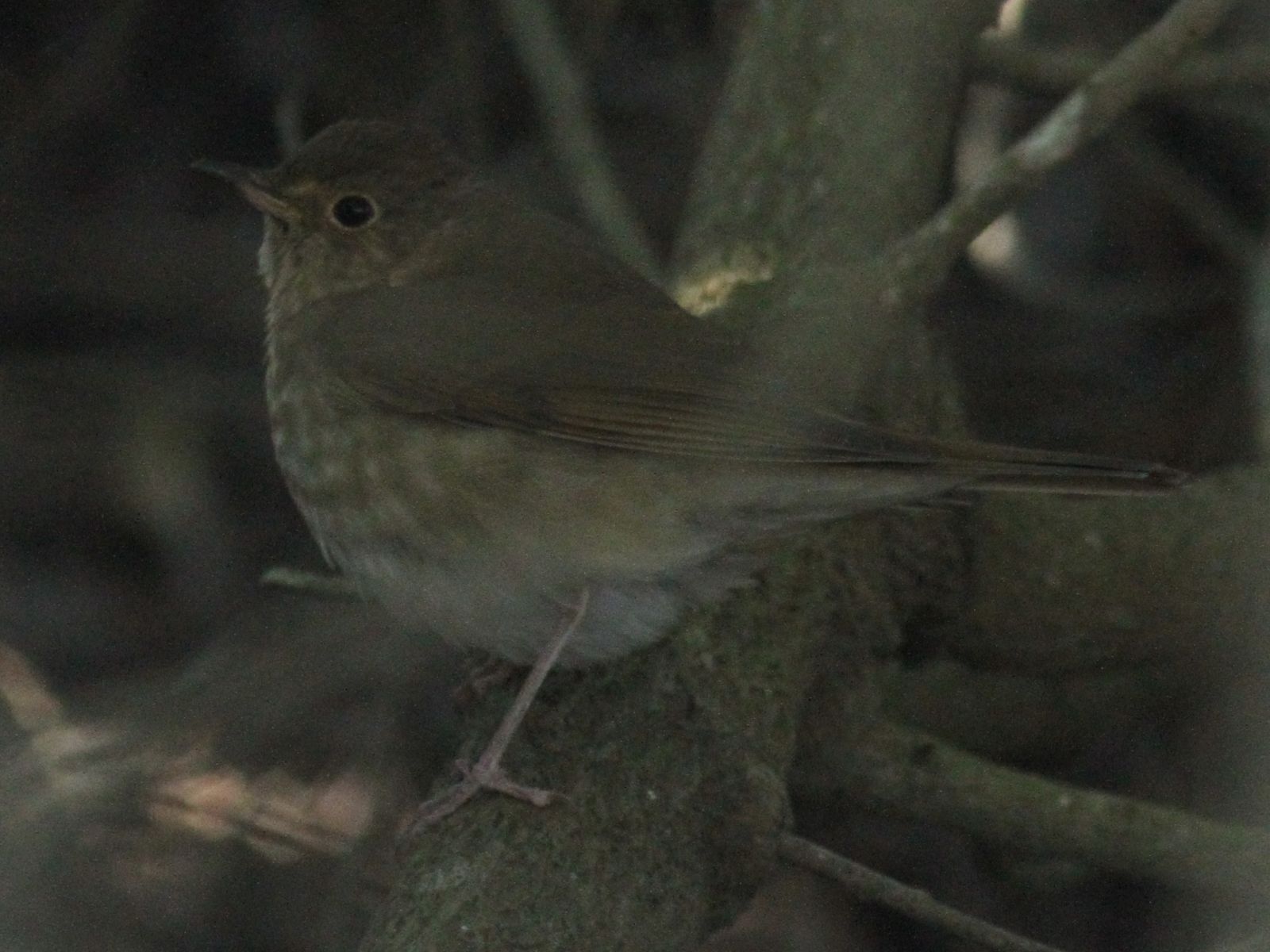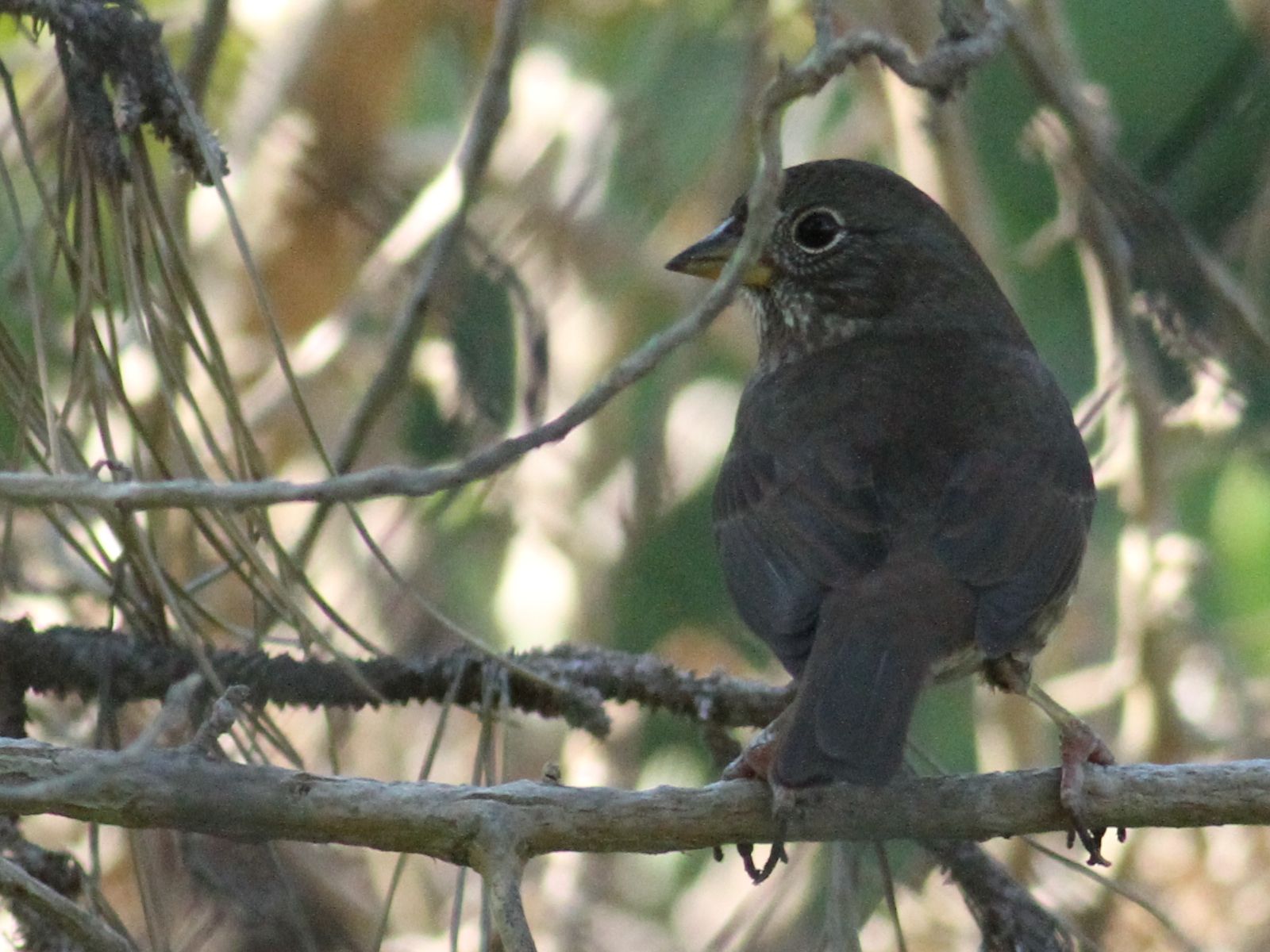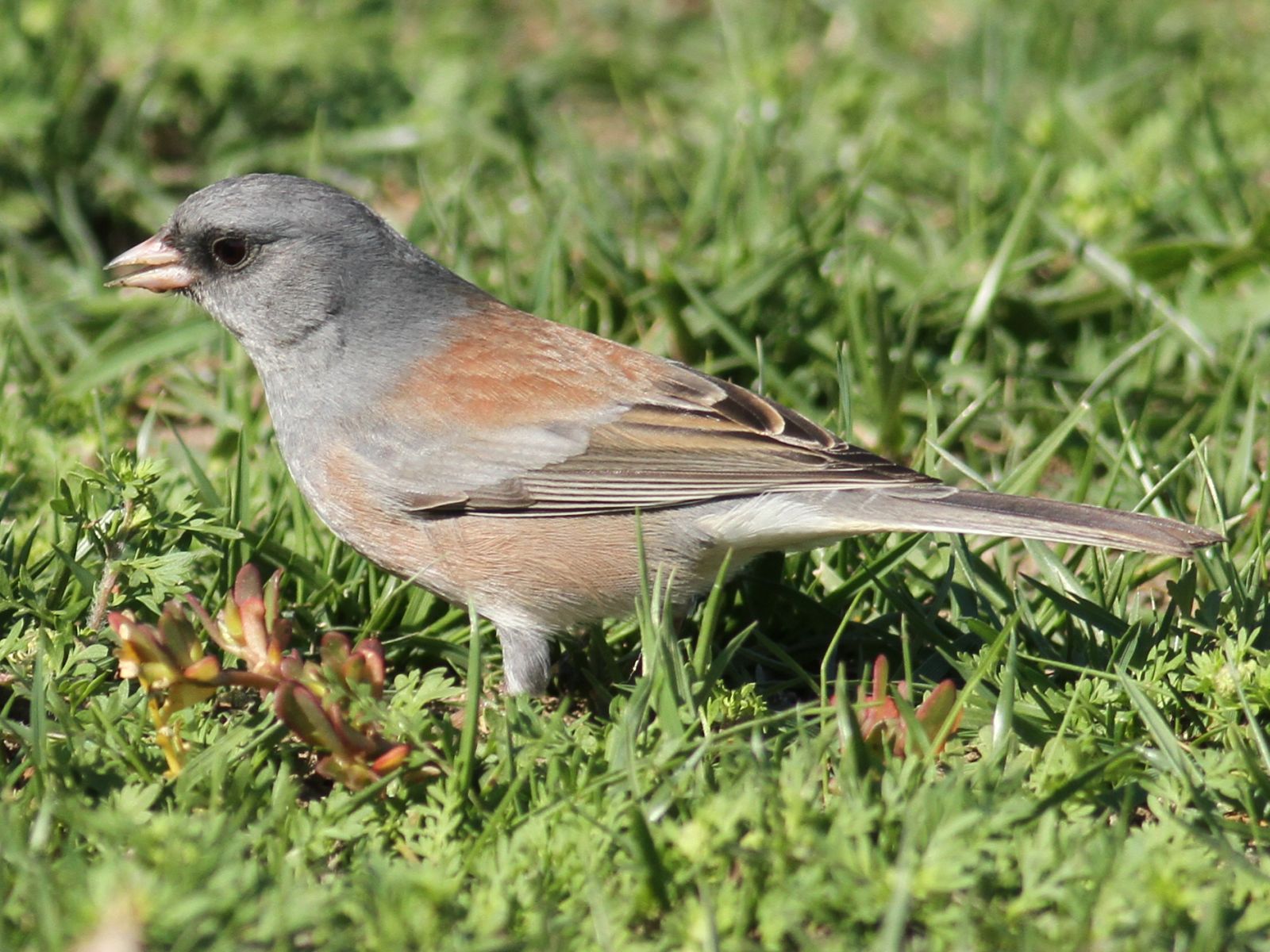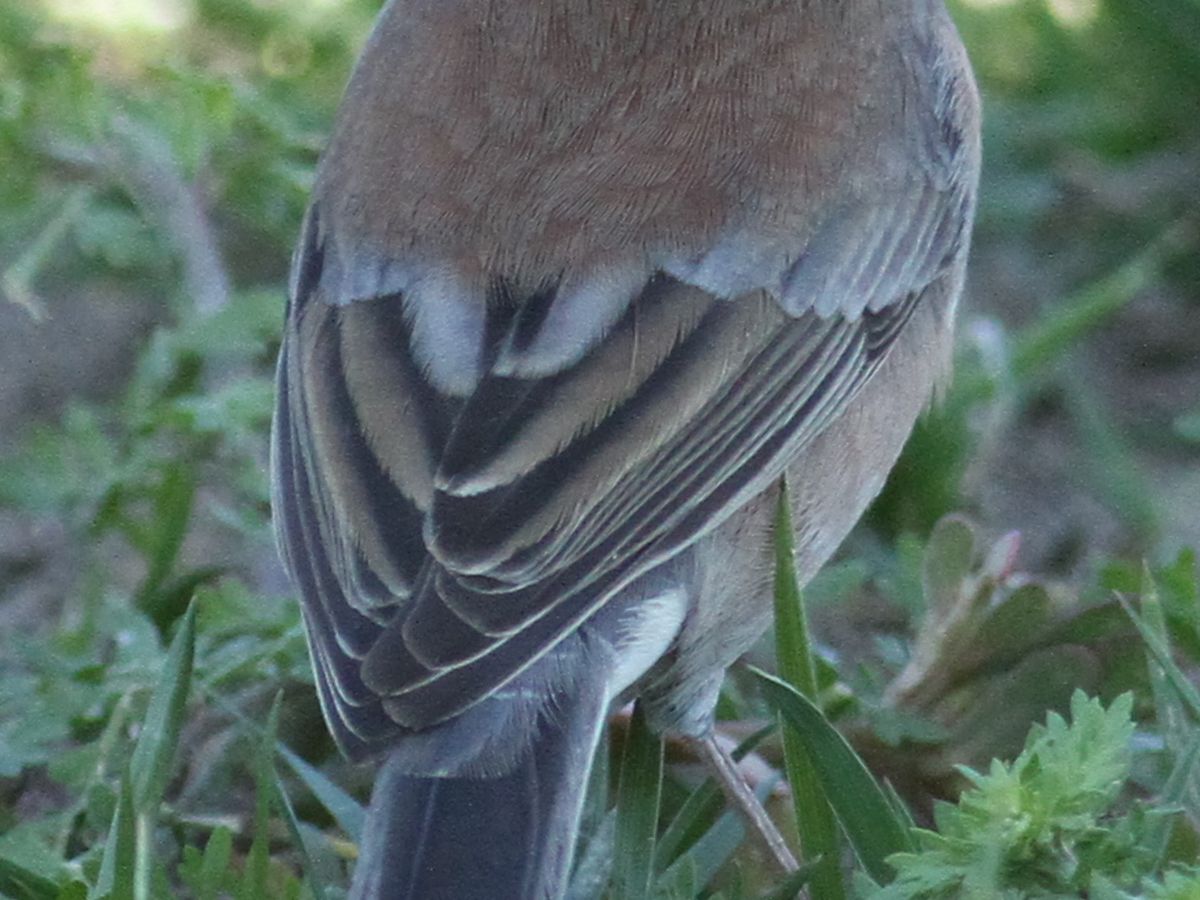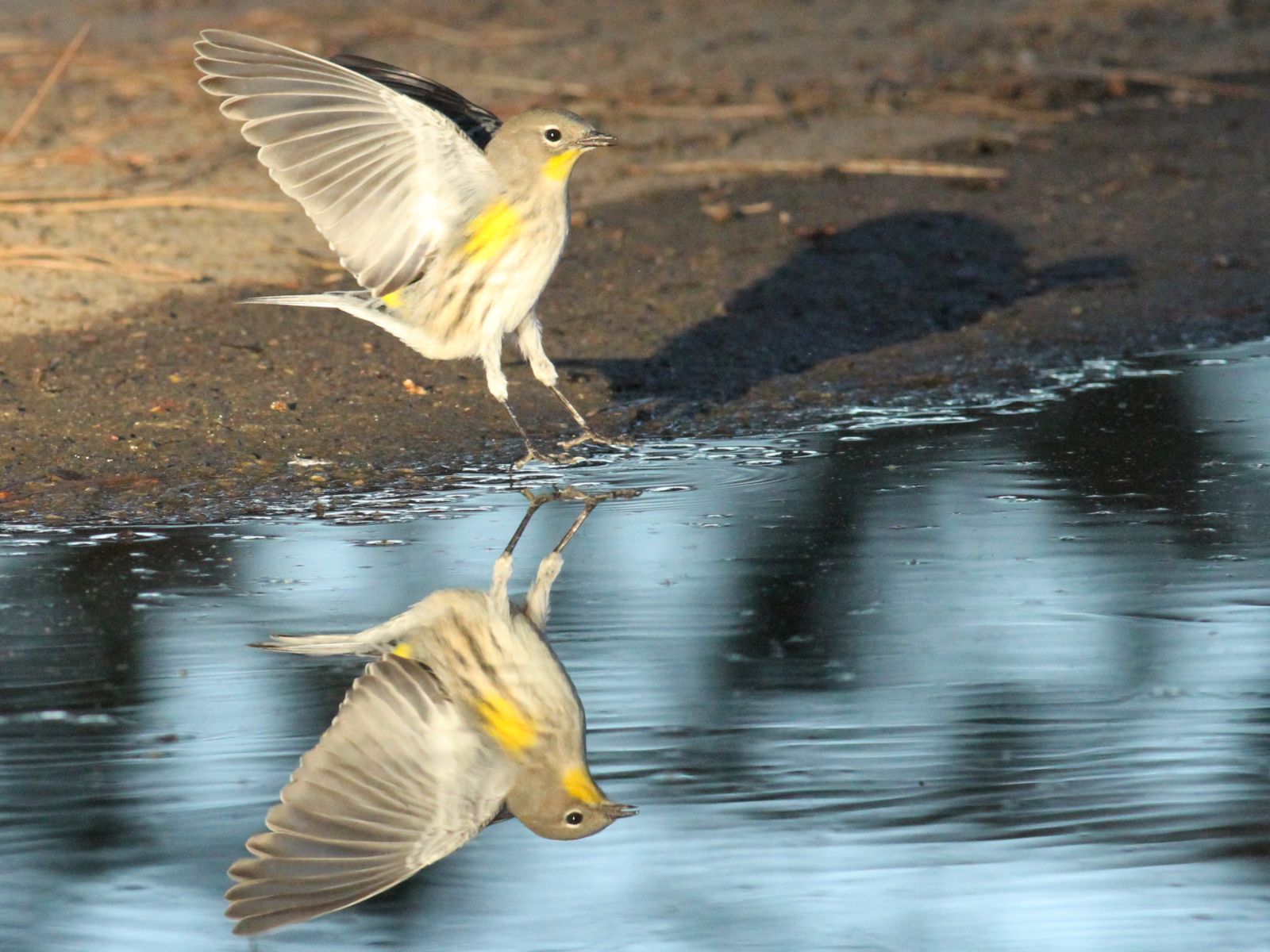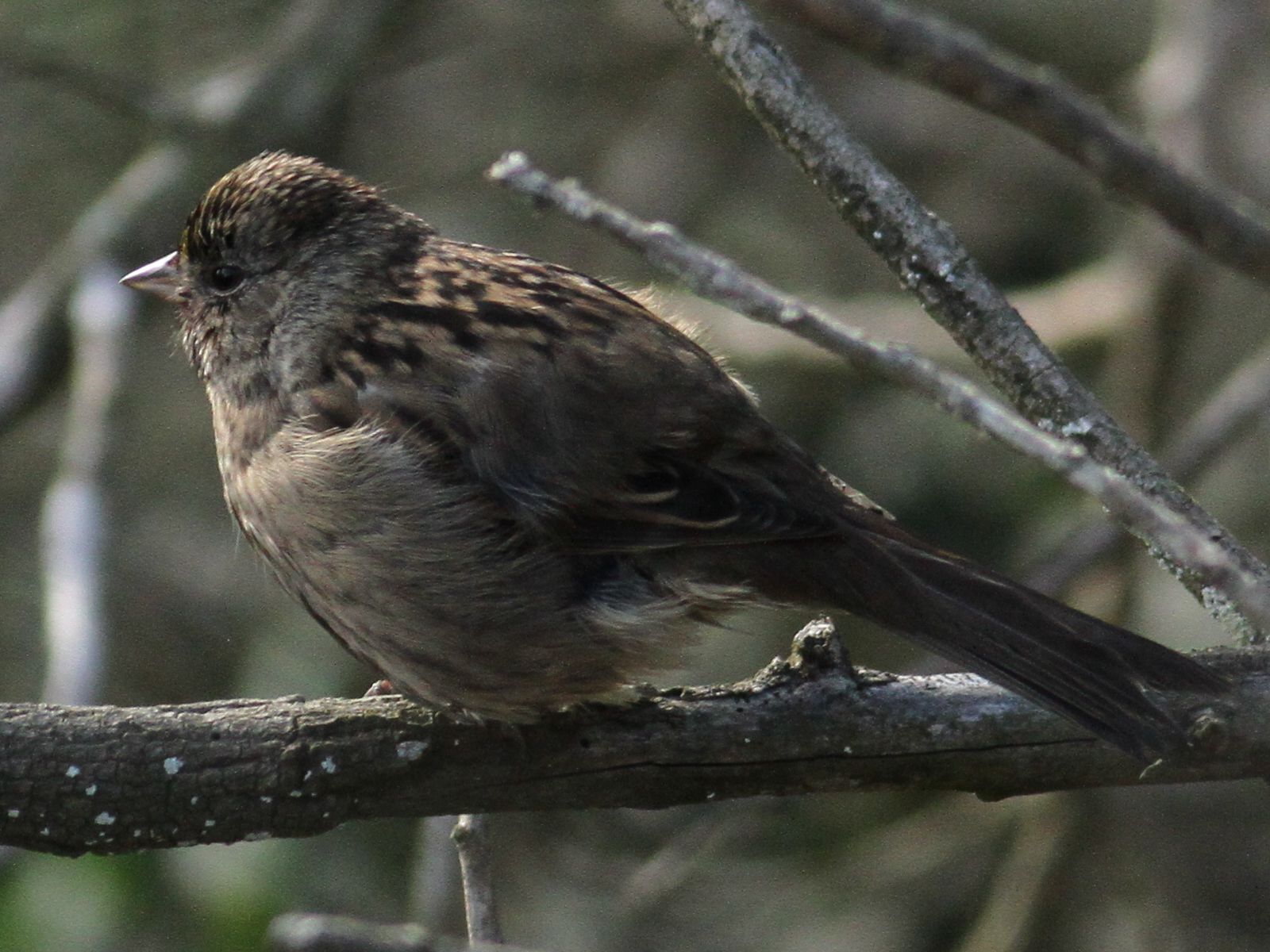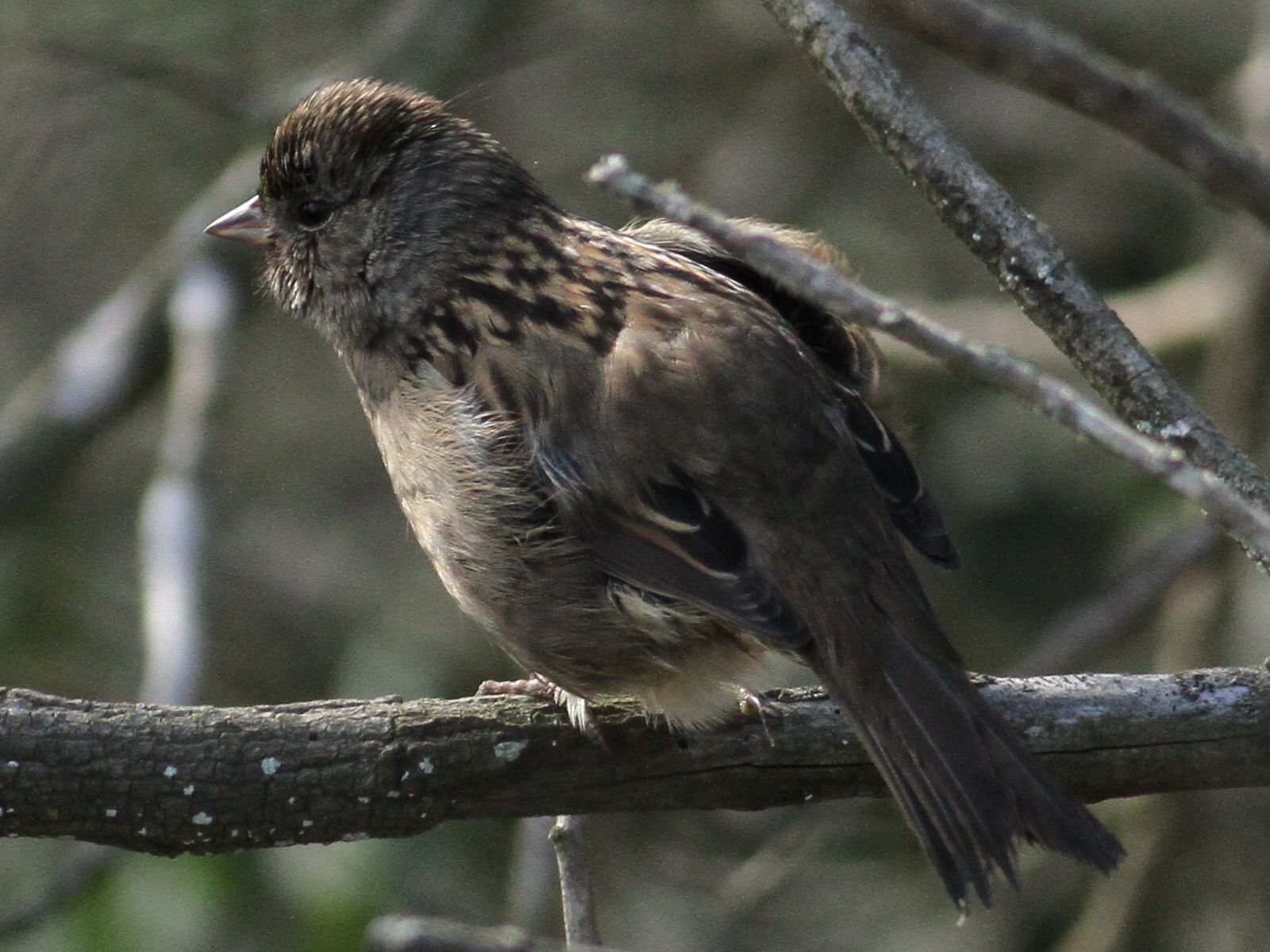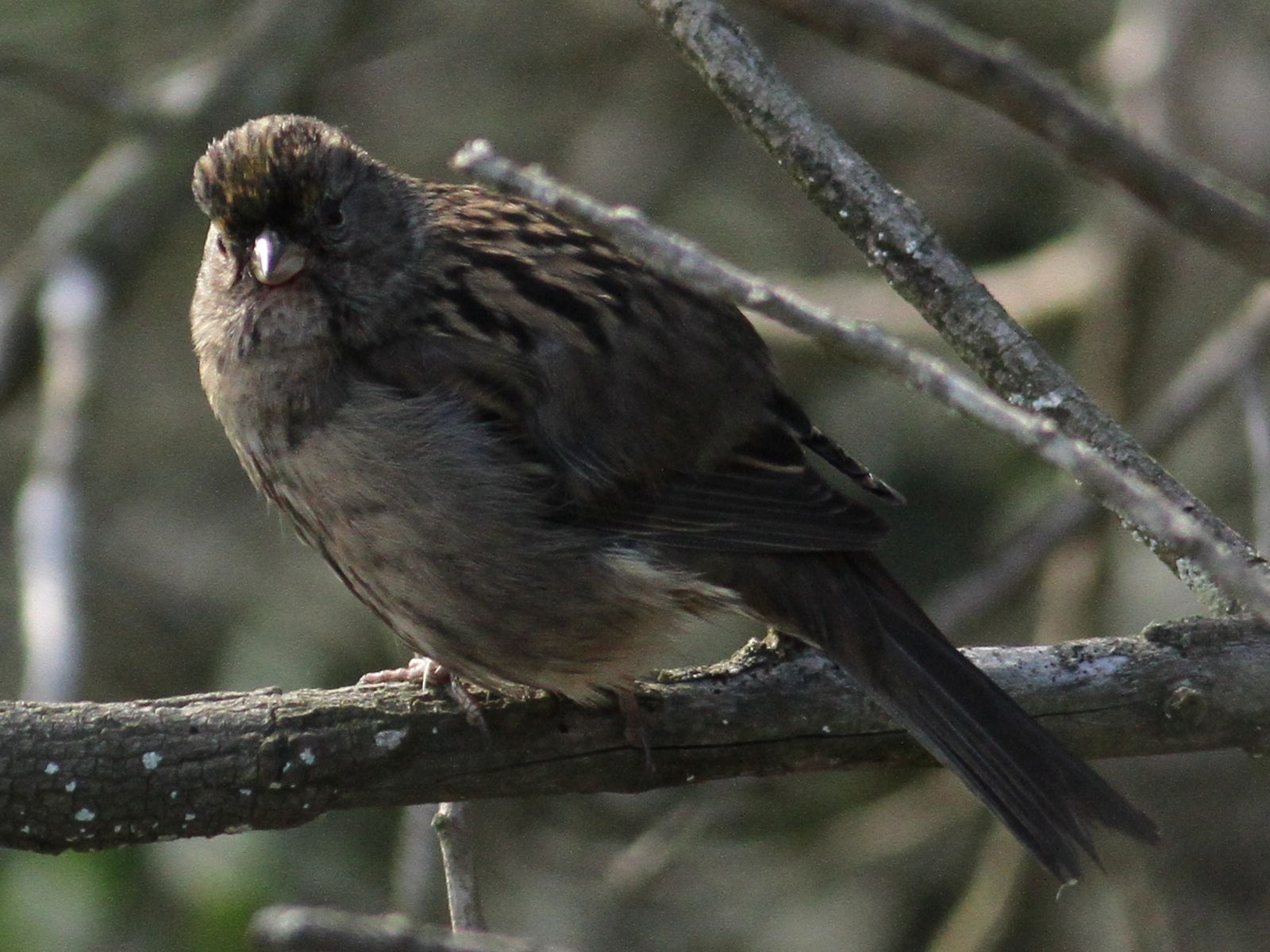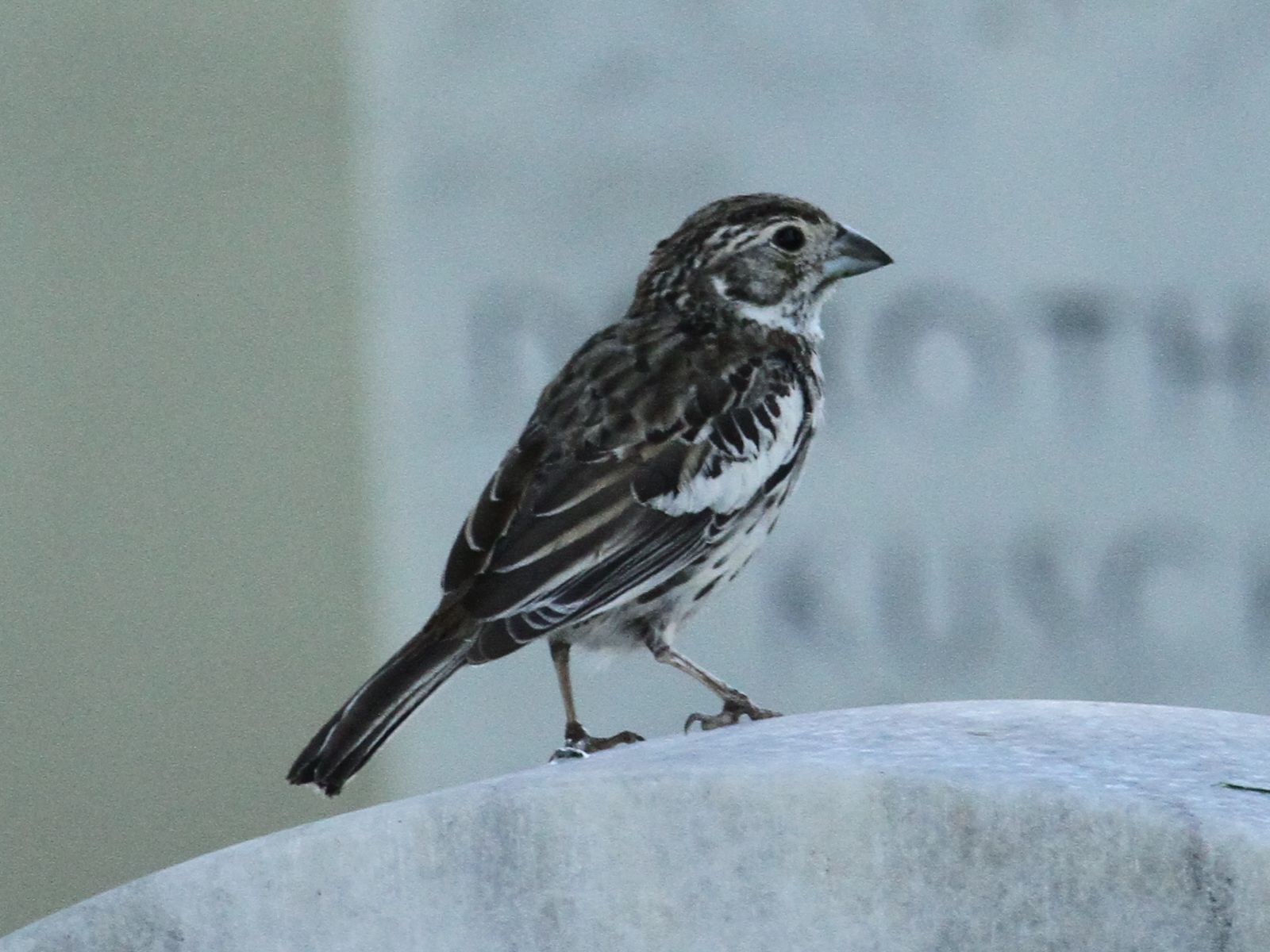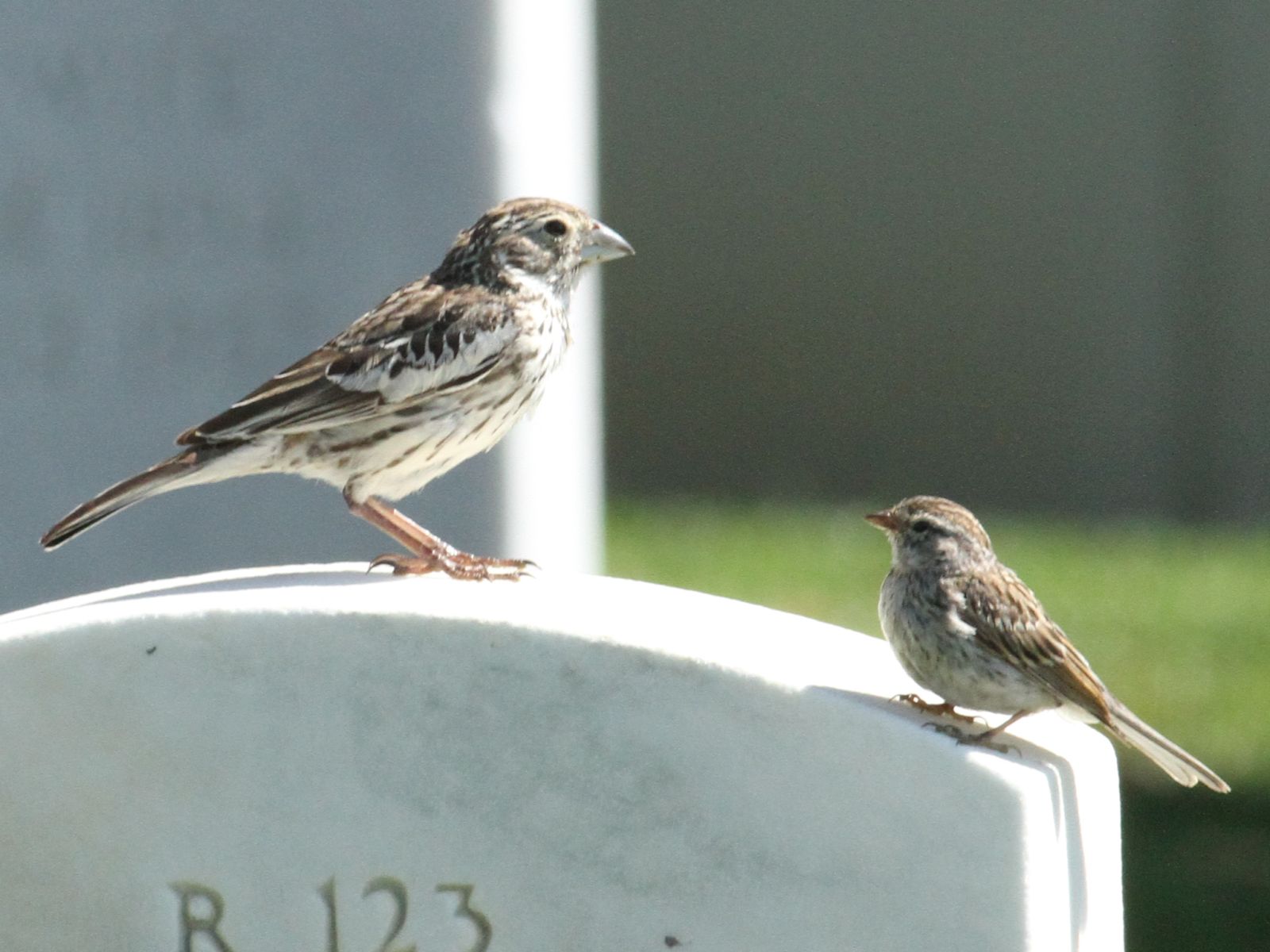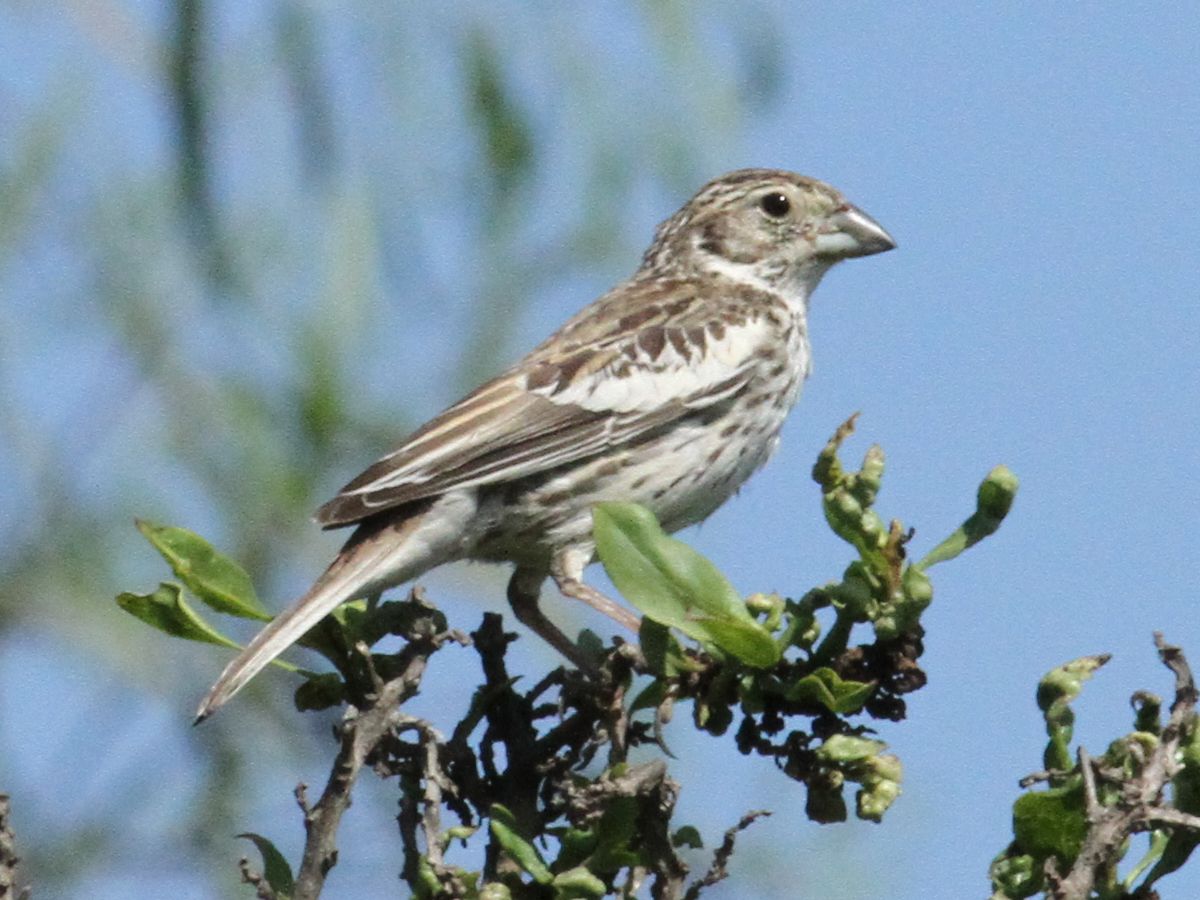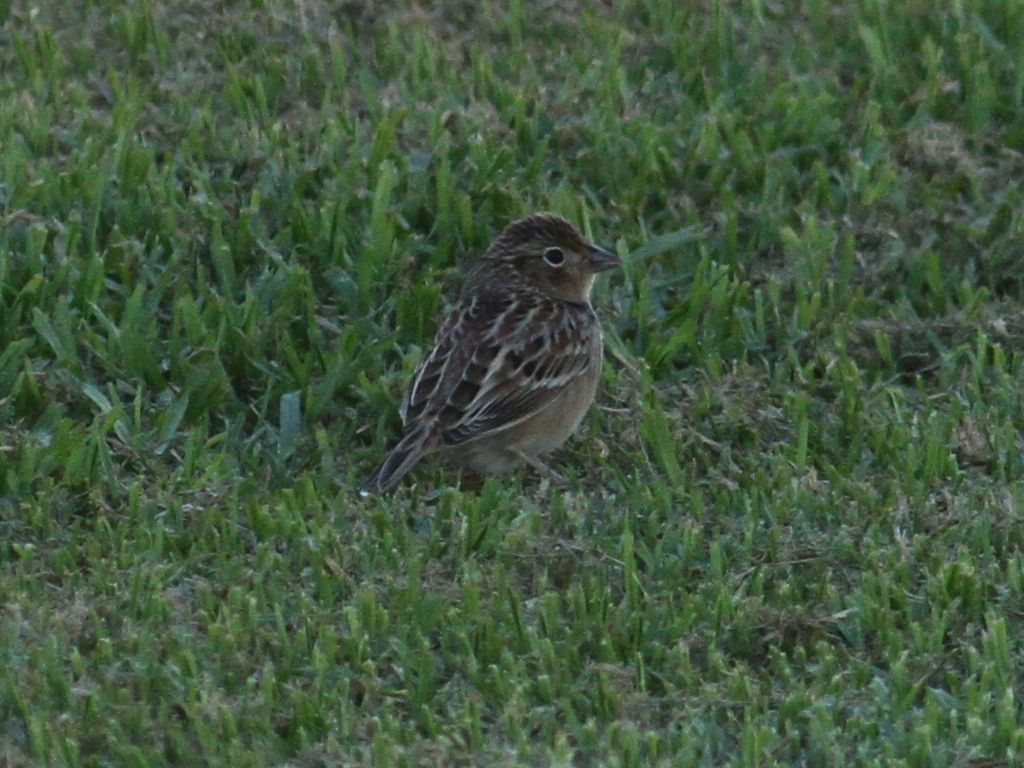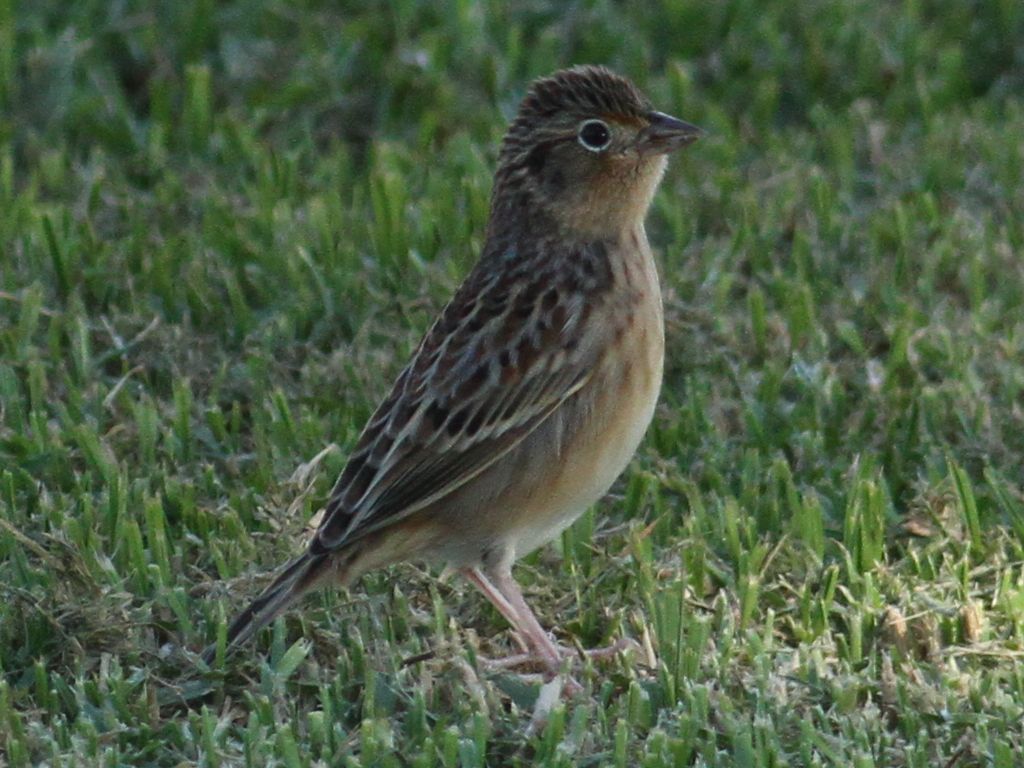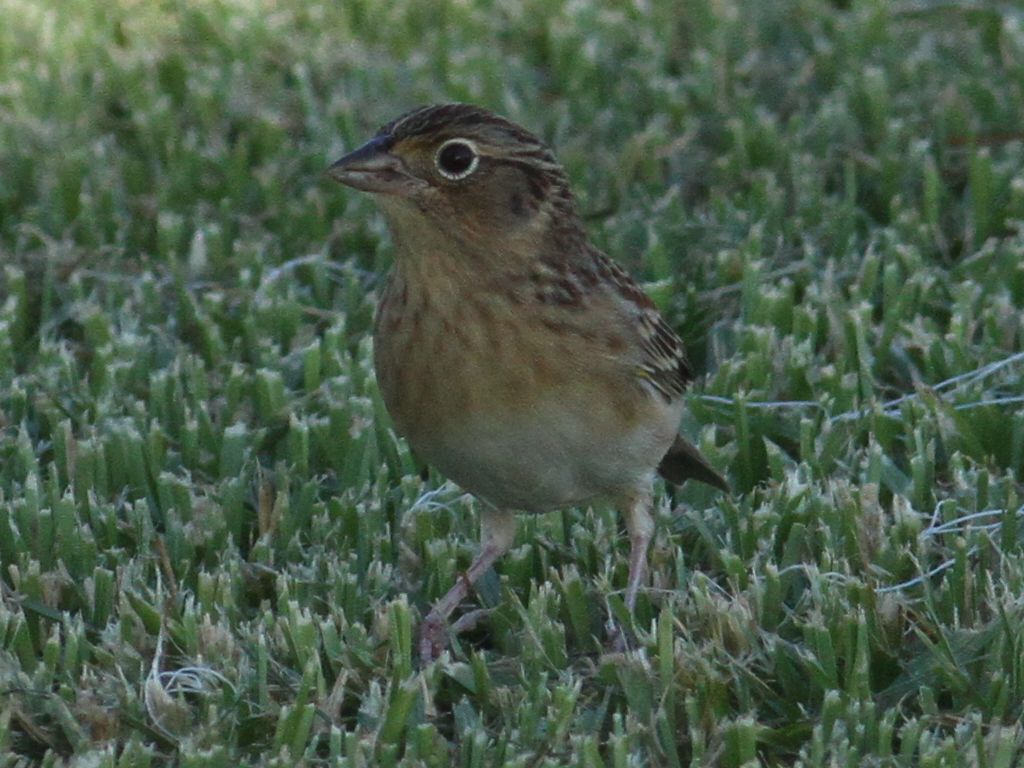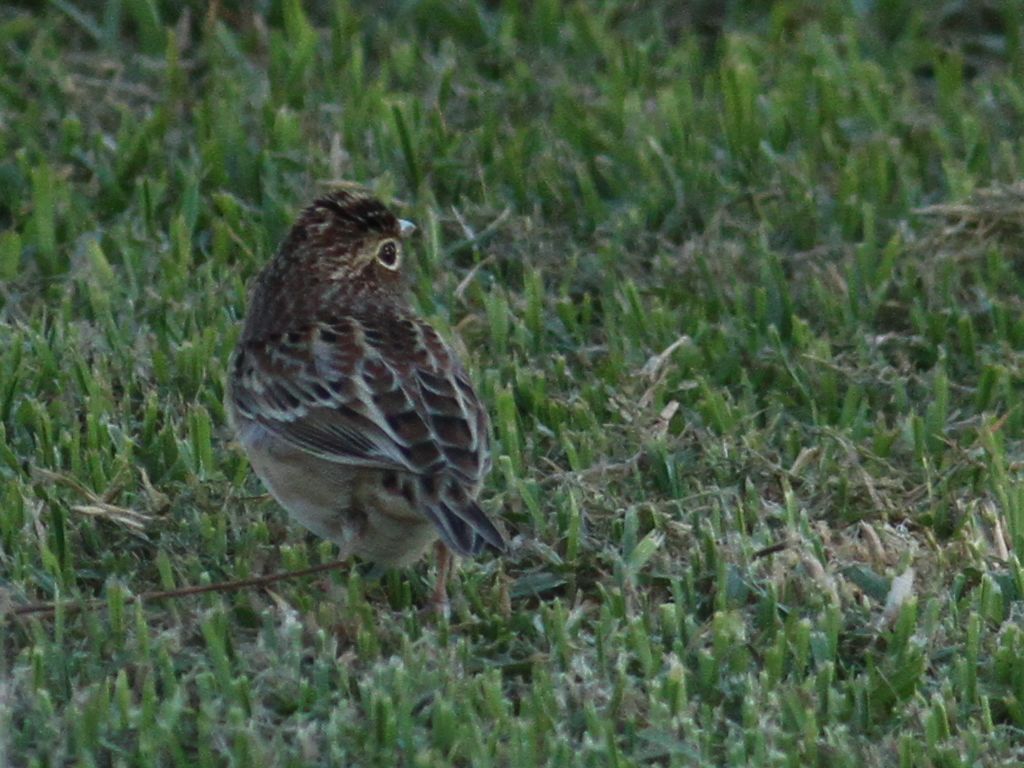[All photographs copyright, Gary Nunn 2014] – The sparrow list seen in the “hot” Chinese Elm at Fort Rosecrans National Cemetery keeps on growing with this crisp and colorful Clay-colored Sparrow Spizella pallida seen on 05 October 2014. This is about as nice an example as I have seen here in San Diego County with rich buffy tones about the plumage and clean head and throat markings.
Category Archives: Sparrows
Thin pickings – one White-throated Sparrow in Point Loma
[All photographs copyright, Gary Nunn 2013] – It is almost mysterious the absence of birds around Point Loma. Even compared to a few days ago, it just emptied of birds. I was about to leave Fort Rosecrans National Cemetery on 30 Oct 2013, as it was getting towards dusk, when a familiar sparrow “seep” call caught my attention. Sure enough I had flushed a White-throated Sparrow Zonotrichia albicollis out of the Pride of Madeira plants and it teed up perfectly on the wall in front of me! After posing for a few photographs it took off with a band of Dark-eyed Junco picking over the roadside debris. This appears to be a first-winter individual still retaining considerable juvenile streaked feathers on the underparts. I think by this date last year I had found half a dozen White-throated Sparrows around Point Loma, so 2013 has been really thin pickings for even the more commonly expected eastern birds.

White-throated Sparrow – Fort Rosecrans National Cemetery, Point Loma, San Diego, California 30 Oct 2013

White-throated Sparrow – Fort Rosecrans National Cemetery, Point Loma, San Diego, California 30 Oct 2013
“Thick-billed” Fox Sparrow in Point Loma
[All photographs copyright, Gary Nunn 2013] – Just before leaving Fort Rosecrans National Cemetery today I heard an unfamiliar, but quite pleasant, bird song just outside the east fence line south of the eucalyptus grove. I walked over and, from some distance, caught sight of the bird singing atop a bush behind the perimeter fence. But then it immediately hopped down out of sight! Viewed from behind the sparrow shaped bird had a large gray head, gray back, rich rufous wings, a long rufous tail, and, particularly noticeable, rufous upper tail coverts demarcated against the gray back. Hmmm, to be honest I was a bit puzzled!
I walked down to the fence and decided to give the “Universal Bird Attractor” (Wrentit chatter call!) a go. I waited a few minutes and was about to give up when, sure enough, out hopped the bird I had just seen. I was impressed to see it was a Fox Sparrow of the megarhynchus group of forms, more commonly known as “Thick-billed” Fox Sparrow! There were in fact two birds traveling together, one with a real honking grosbeak sized bill and the second a bit smaller billed.
It seems most likely both these birds are of the Passerella iliaca stephensi form found breeding in Southern California including just a handful found summering on the highest mountain tops in San Diego County. “Thick-billed” Fox Sparrows are only known to migrate a short distance moving to lower elevations in the winter near to their breeding range. So most likely these two birds originated nearby or from the southern Sierras.
I was confused by the bill color of these two individuals which both show some orange-yellow coloration on the lower mandible, and in one bird the upper mandible. What’s puzzling is that Thick-billed Fox Sparrows are illustrated in field guides with uniformly gray-colored bills. However after researching this point a bit further, including Jim Rising’s excellent The Sparrows of the United States and Canada illustrated by David Beadle, I discovered that outside the breeding season the bill can be more orange-yellow, and was in fact illustrated this way in older descriptions of these large-billed forms of Fox Sparrow. The Handbook of the Birds of the World, Vol. 16, already treats the four natural groups of Fox Sparrow as full species and also mentions the bill coloration being more orange-yellow outside the breeding season for the “Thick-billed Fox-sparrow” (note the logical new common name).
The Fox Sparrow complex is almost certainly headed towards a more progressive taxonomic treatment when it will be subdivided into its four natural groups – Red, Sooty, Slate-colored, and Thick-billed. This could prove interesting for San Diego County birders since all four have been found here in the county! I would recommend keeping a careful note of when and where you have seen these very different looking forms of Fox Sparrow.
Point Loma bird haul – Yellow-green Vireo and more
[All photographs copyright, Gary Nunn 2013] – It is always nice when you set off birding and quickly run into a bird species you’ve always hankered after finding yourself. I’m the first to run after other people’s good birds but I think self-found birds are so much more satisfying! I was only talking about this exact species the other day, and there it is, a Yellow-green Vireo Vireo flavoviridis at Fort Rosecrans National Cemetery! I first located it around 7:30 am and it was seen on-and-off until at least 12:30 pm allowing many people, including a large birding tour group from England, to obtain looks as it fed in the Ficus tree. This bird is almost a year to the day since Sue Smith discovered one here at the cemetery on 26 Sep 2012. I could hardly believe my good luck!
In spite of the muted early morning light, thanks to coastal marine layer clouds, you can still see nice bright yellow-green coloration on the undertail coverts and breast sides. It also shows off the paler grey crown coloration and darker penciled eyebrow above the indistinct supercilium. The bill is classic pinkish for this species with a few small greyish dark marks near the cutting edges. It seemed to like gulping down some of the berries on the Ficus tree and then retiring into the canopy for a while!
I have been following this Tennessee Warbler around at the cemetery for a while now so was very happy to finally get some photographs. This is a nice brightly colored first fall individual with bright yellow suffused on the breast. It was traveling with a couple Orange-crowned Warblers and a Warbling Vireo. Viewed from below it shows a very short tail and long white undertail coverts giving the bird a compact appearance overhead. Should you be lucky enough to see the back it is a lovely rich green color!
The haul of eastern warblers continued when Jim Roberts reported a very spic-and-span looking Chestnut-sided Warbler also at the cemetery. Luckily I ran into it picking over low open boughs of a big Ficus tree where I got some nice photographs. The yellow patches on the rear flank behind and above the leg can be clearly seen in this photograph.
Finally after watching over flocks of endless Chipping Sparrows out jumped this bright buffy colored Clay-colored Sparrow. I think in this plumage they are quite easily told from Chipping Sparrows showing off its buffy-suffused breast sides and dark malar stripes which create a well defined white throat.
Double take – Golden-crowned Sparrow in molt
[All photographs copyright, Gary Nunn 2013] – I spotted this interesting looking Golden-crowned Sparrow at the south end of Famosa Slough, Point Loma on 13 March, 2013. It appears to be in prealternate molt showing off plenty of black feathering in the cap. Nice dark colored feathers are growing in about the head, and new, darker, central rectrices appear to be growing in also. In addition the tertials and inner greater secondary coverts, at least four, look very fresh and richly colored, particularly compared to the worn and faded primaries visible in the folded wing.
The mix-and-match feathering of the head really creates a striking looking pattern – I had to take a second look just to convince myself what was going on here! In the lateral crown stripes the mixture of brown and black colored feathers looks pretty unusual. Maybe there is only a short time-frame here in Southern California when we would see such a head pattern in this species but an appearance worth keeping in mind. Golden-crowned Sparrows seem to be thinning out in numbers right now at my favorite spots in Point Loma. At places where I had seen 4 or 5 individuals before, now there are just odd ones and twos present.
Swamp Sparrow in Jacumba
[All photographs copyright, Gary Nunn 2012] – The wind and cool weather kept the birds quiet at the riparian area on the west side of Jacumba late this afternoon. So I explored a bit downstream from the hot water seeps, getting out of the wind, and found some nice stands of bulrush backed by willows. I made a few pishing sounds and immediately heard a phoebe like call coming from low down in the vegetation. A couple seconds later and up popped just what I was searching for – this richly colored Swamp Sparrow Melospiza georgiana.
The clean gray nape and supercilium and well marked rufous in the crown indicates this is an adult Swamp Sparrow. The small finer looking bill, pale brown upper back color, and brightly colored flanks, point to this being the expected form “Northern” or “Western” Swamp Sparrow to be found wintering in California M.g. ericrypta.
This would seem to be a banner year for this delightful sparrow in San Diego County. The first record of the fall came back on 31 Oct 2012 when one was found by Paul Lehman at Famosa Slough. By coincidence, another individual was also found by Jay Keller today, 17 Nov 2012, at the Bird and Butterfly Garden in the Tijuana River Valley. This brings the Fall 2012 total to three records so far in the county. Perhaps there are more Swamp Sparrows out there to be found!
FRNC – October 27-28 weekend highlights
[All photographs copyright, Gary Nunn 2012] – I am reckoning at least two, and possibly three, White-throated Sparrow Zonotrichia albicollis have arrived at Fort Rosecrans National Cemetery. The first one I encountered on Saturday, a nice “tan-striped” color morph with streaked flanks, shown below entering through the fence, was traveling with a band of Dark-eyed Junco. On Sunday I saw at least one brighter “white-striped” color morph individual that alighted in a small pine at dawn. Later on a very brightly plumaged bird came out on the grass in front of me. Here are three photographs from different times over the past few days and different locations at the cemetery.
A “warm biscuit” colored Catharus thrush hiding behind the south fence on the east side got my pulse going. Repeatedly scared off by a Hermit Thrush, it eventually plucked up courage to reveal itself – a getting late Swainson’s Thrush Catharus ustulatus. This bird only shows a weak buff eye ring and supraloral. Although a nice warm overall color on the upper parts, and with a buffy bib across the upper chest (not visible in this photograph), the clearly buff flank color points to Swainson’s Thrush and not a much rarer Veery.
This shaggy maned Western Scrub-Jay Aphelocoma californica shows off the dark purplish blue of the local obscura race found here on the southwest California coast. Freshly molted, I think the local jays look spectacular at the moment. I only noticed later that this individual is sporting “jewelry” on its left leg!
I only detected the first Fox Sparrow Passerella iliaca yesterday behind the southeast section south fence. It was joined today by a second identically warm brown colored individual. Both birds had a slight reddish hue to the warm brown upper part color, evidently part of the “Coastal Northwest Sooty” unalaschcensis group of Fox Sparrows. Difficult to approach they remained so well hidden that I only managed this wary photograph through the fence.
The diversity of types of Dark-eyed Junco is climbing steadily at the cemetery. Over the weekend this nice “Pink-sided” Junco Junco hyemalis mearnsi appeared among the more numerous “Oregon” type. Without even looking through your binoculars this type of junco stands out by its size, it is quite a bit larger than the “Oregon” type.
This Pink-sided Junco may be a hatch year (HY) male – it appears to have completed first prebasic molt but retained what looks like a couple of juvenile tertial feathers on each wing (brown edged and tattered looking when magnified). The new molted smallest tertial (s9) matches the color of the other freshly molted greater secondary coverts (pale grey new feathers).
I sat down next to this puddle in the early morning and waited as Yellow-rumped Warblers came to drink. I caught this one alighting at the puddle edge. You can see many plumage details in the reflection as clearly as the actual bird image! In fact if you look closely parts of the reflection show feathers not visible on the bird itself, for example the underside of the tail!
The very large Golden-crowned Sparrow
[All photographs copyright, Gary Nunn 2012] – In the early morning of 05 Oct 2012 I was looking over “The Wall”, along the east side of Fort Rosecrans National Cemetery, when a very large sparrow hopped up in among dead twigs below me. It had me puzzled from the back view for a moment but soon shuffled around on a branch revealing itself. I popped the telephoto lens over the wall and got a few nice shots of my first Golden-crowned Sparrow Zonotrichia atricapilla of Fall 2012.
The San Diego Bird Atlas indicates this species arrives here in the county in the first week of October, so this rather exhausted looking individual was right on time. Squinting its eyes at me in the bright morning sunshine, it really looked as if it had been on the wing all night and had barely a chance to rest before I found it. The streaked underparts indicate this is a juvenile Golden-crowned Sparrow. It had found its way almost to the southern limit of the wintering range of this species which regularly extends only a few hundred more miles down Baja California Norte, Mexico.
This species completes part of its first prebasic molt on the breeding grounds and this individual does look as if it has a mixture of newer richly colored feathers and some very worn tattered feathers too. The fluffy feathered head has some nice looking new black feathers coming in on the crown stripes above the lores (this individual is at the darkest end of the range for a hatch year bird). The tail by contrast is a real worn out tattered mess already with nothing but spiky ends to some of the rectrices.
There is a single field character of this species which easily separates it from all White-crowned Sparrow plumages – the absence of a median crown stripe on the head. Often loose sparrow flocks seem to always be looking at you from their sides, yes birds have eyes on the sides of their heads! But get a look at them from head on and the Golden-crowned Sparrow is virtually unmistakeable with its golden peppered crown bordered only on the sides by darker stripes. In addition it is very large, when found alone that is not so useful, but in a mixed flock with White-crowned if there is one “big” sparrow then it could well be a Golden-crowned.
I usually see small numbers of Golden-crowned Sparrow around Point Loma but they appear in a wave and then peter out to being quite scarce there later in the winter. Some nice looking black and gold crown striped alternate plumaged individuals, breeding finery, can also be found here in the early spring time – those are always a nice find.
Enormous Lark Bunting – Point Loma
I knew something was up this morning here in San Diego when I found a migrant Common Yellowthroat in my backyard in Pacific Beach. Now that is unusual and probably a sign to look further afield! So off I went for a quick tour of Fort Rosecrans National Cemetery. I was following a small flock of mixed birds in the northwest section, darting up and down from pines to the ground, when an enormous grosbeak like bicolored bird jumped up on a grave marker! Not a grosbeak though, showing off its big white shoulder epaulets this was a much rarer Lark Bunting Calamospiza melanocorys. I followed it around for just a few minutes obtaining some photographs before it hopped the north fence line and was gone!
The enormous size of this “sparrow-like” bird can be appreciated when seen perched next to a diminutive Chipping Sparrow! Standing together on top of the grave marker, the Lark Bunting looks as if it could almost tuck the smaller sparrow under its wing!
Lark Bunting is a rare visitor to San Diego County and I had encountered another individual here almost one year ago on 18 Oct 2011. Last year seems to have been a bumper crop with another individual found by Paul Lehman on 6 Nov 2011 further east in the county in the agricultural field edges at Jacumba. In recent years large flocks of this species have been observed in Arizona, sometimes numbering in the multiple hundreds of individuals per flock. Perhaps a wintering range expansion or increase in numbers could be driving the increasing frequency this species is encountered here on the California coast.
Luckily the Lark Bunting reappeared later in the day and many other people observed it at the cemetery.
“Western Grasshopper Sparrow”
[All photographs copyright, Gary Nunn 2012] – This delightful looking Grasshopper Sparrow Ammodramus savannarum was out on the open short turf at Fort Rosecrans National Cemetery and allowed some detailed photography of its amazing plumage coloration. This is the western perpallidus form of Grasshopper Sparrow, first described by army surgeon and field ornithologist Elliot Coues from the western US in 1872. This form of Grasshopper Sparrow breeds from western Canada south to San Diego and across east to Texas. It has sometimes been called the “Western Grasshopper Sparrow” to separate it from other forms of this North American species. It has never been elevated to separate species level but always considered a form of the widespread Grasshopper Sparrow.
The richly colored dark buffy-orange supraloral spot, just ahead of the eye and above the pale straw colored loral region, is a distinctive character of this form of Grasshopper Sparrow. In addition the rich buff colored wide margin of the underparts, with blurred chestnut brown short streaks included (only found on this form of Grasshopper Sparrow), is another good field character when encountering this small Ammodramus. The pale buffy-white belly patch, surrounding the legs and on the fore-belly, is also distinctive, particularly when the bird stands up high on its legs looking straight at you or when seen taking a short flight.
Everywhere you look on this sparrow there are dark chestnut, gray, blackish, and buff colors changing abruptly across the feathers on the upperparts. The pale feather fringes add to the complexity of the overall pattern, almost too many details to absorb at first sight.
The underparts appear richly buff colored, almost glowing gold colored from a distance. It can be told from its congeners by the gray supercilium, or eyebrow, to the rear of the eye, the buffy auriculars and the complete and bold eye ring. Personally I think the head looks large and rounded with a large eye although it can flatten the crown feathers to appear flat headed as in the photograph below. I also think the spiky raised gray and chestnut peppered feathers of the crown are a neat field character, with the paler straw colored median crown stripe contrasting prominently.
The neatly colored tertials are pretty amazing on this sparrow – dark chestnut and black with a pale whitish margin to the complete feather. They form a unique looking twin set of ladder markings up the back of this colorful sparrow. One of my absolute favorites and always a pleasure to study up close!

